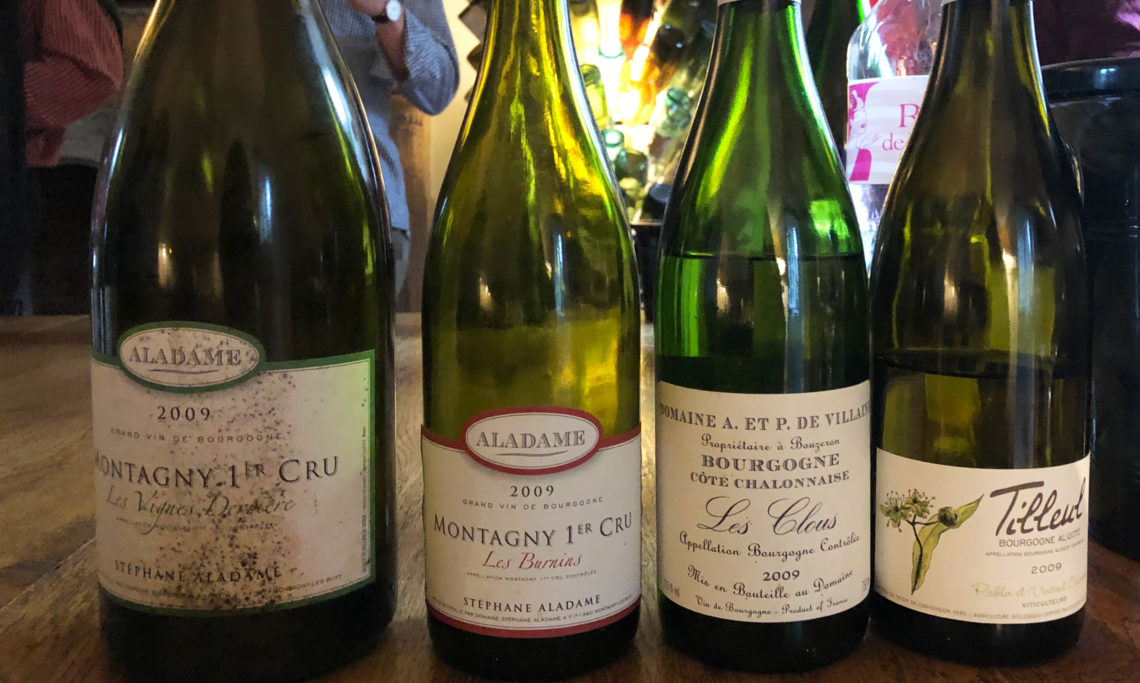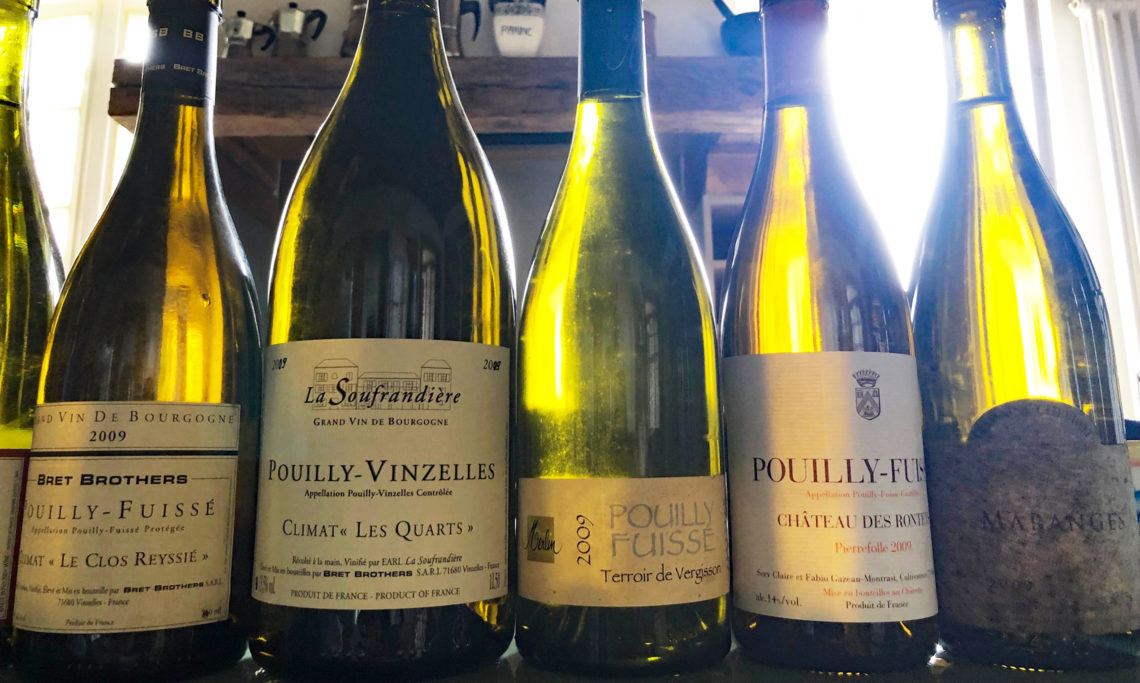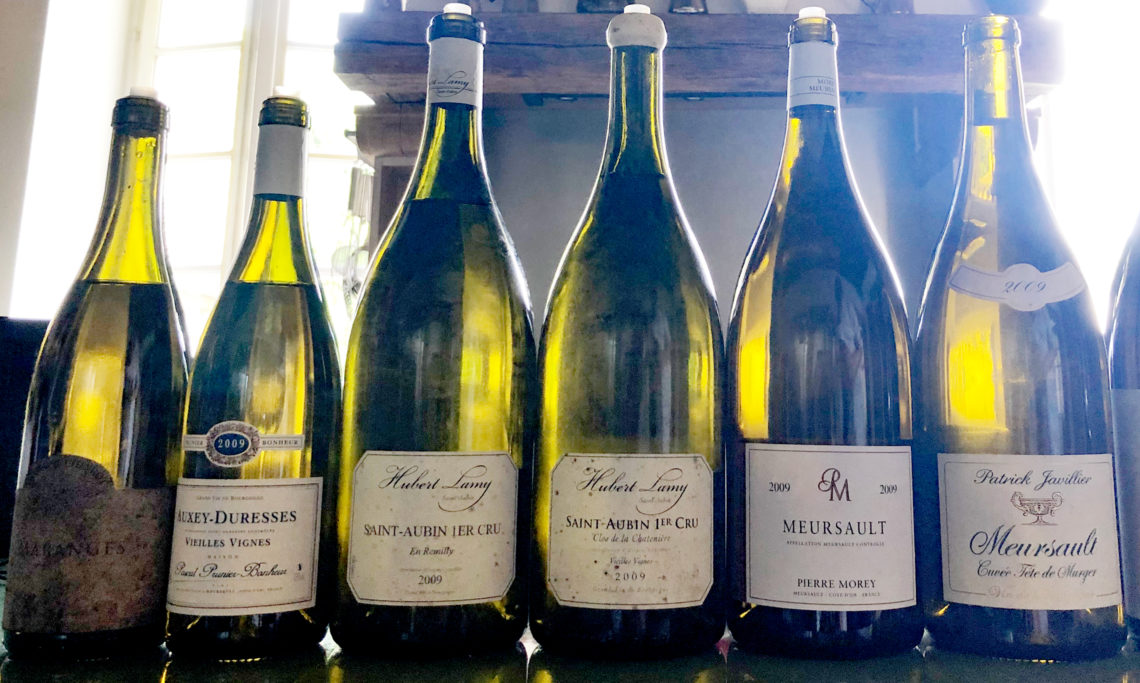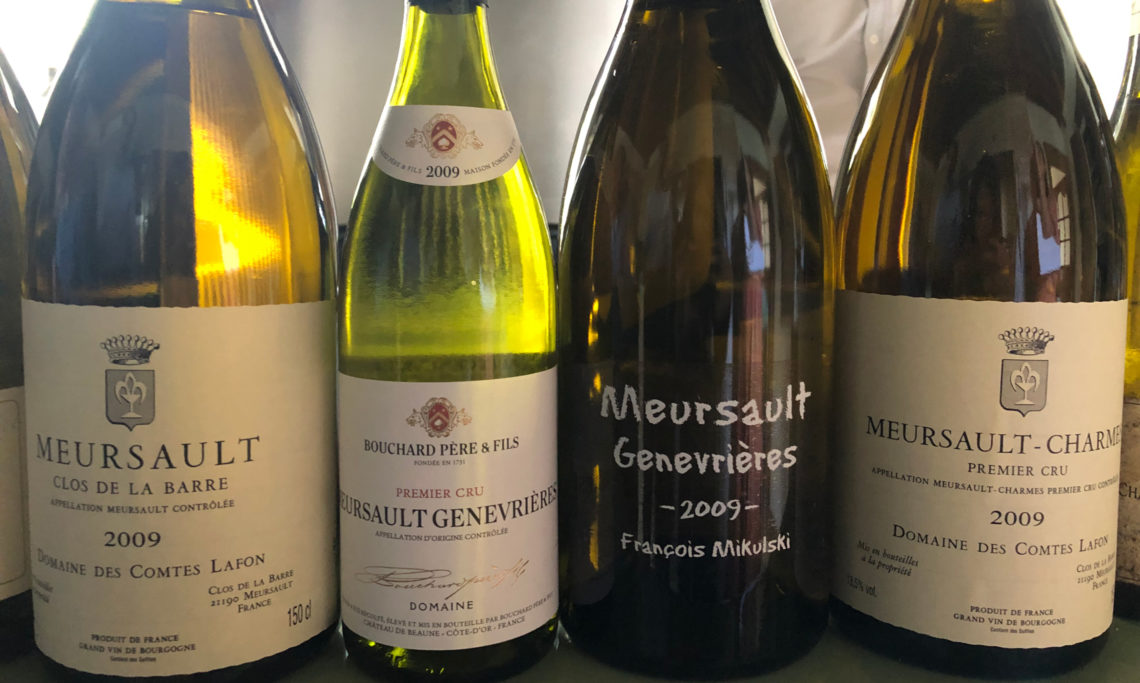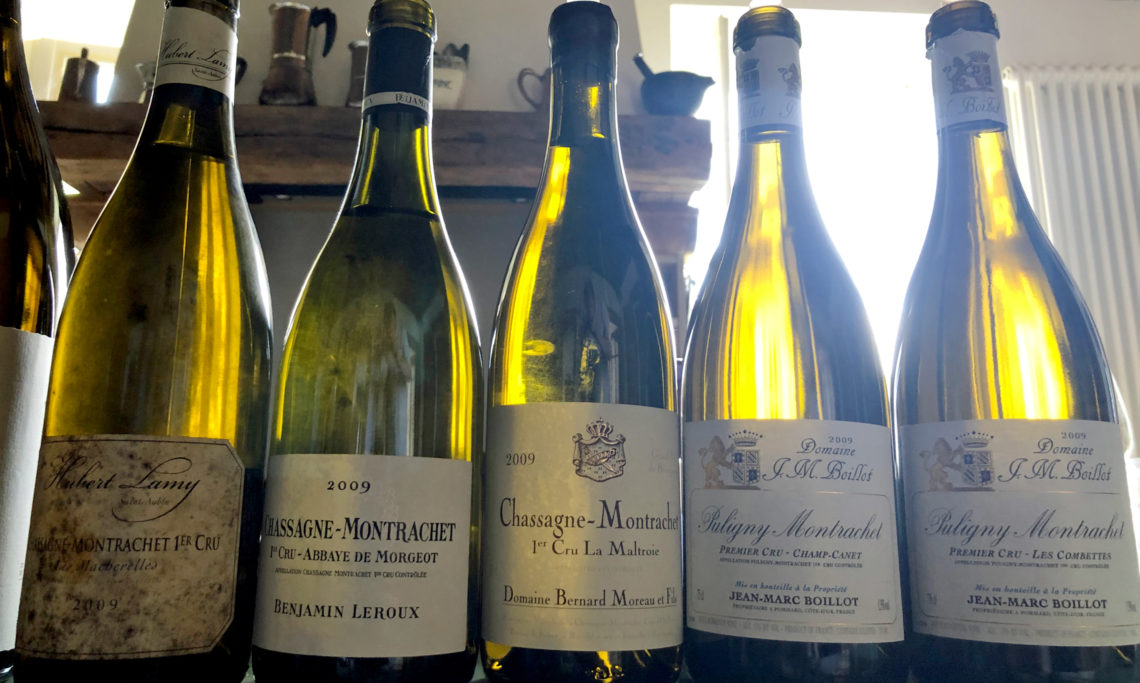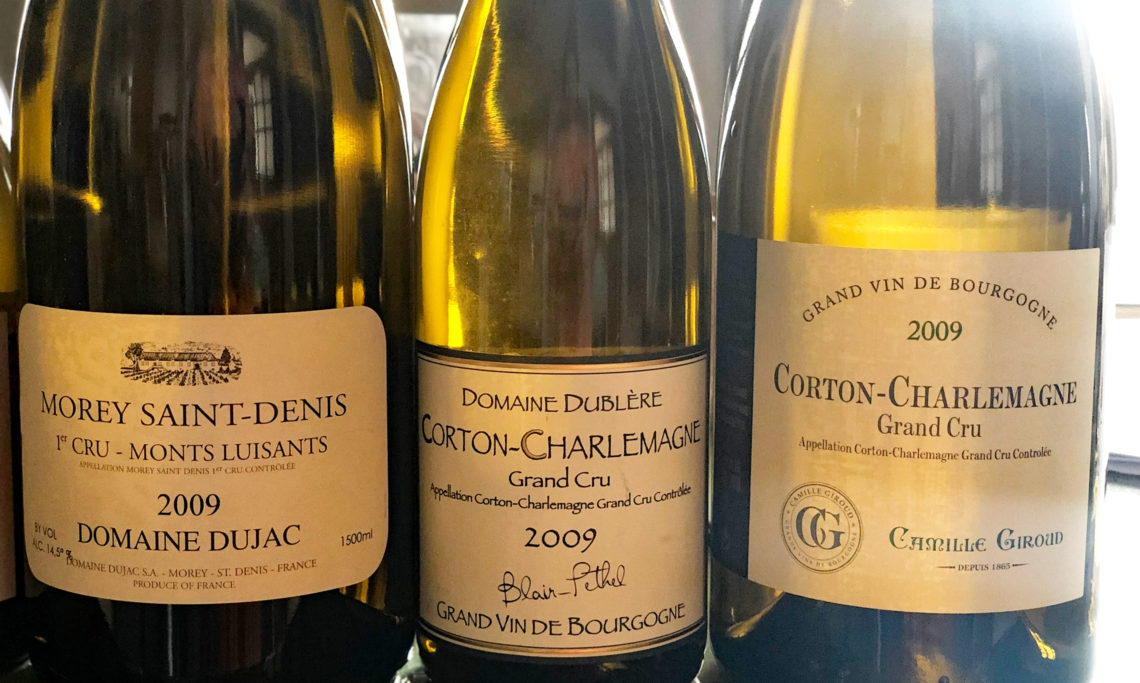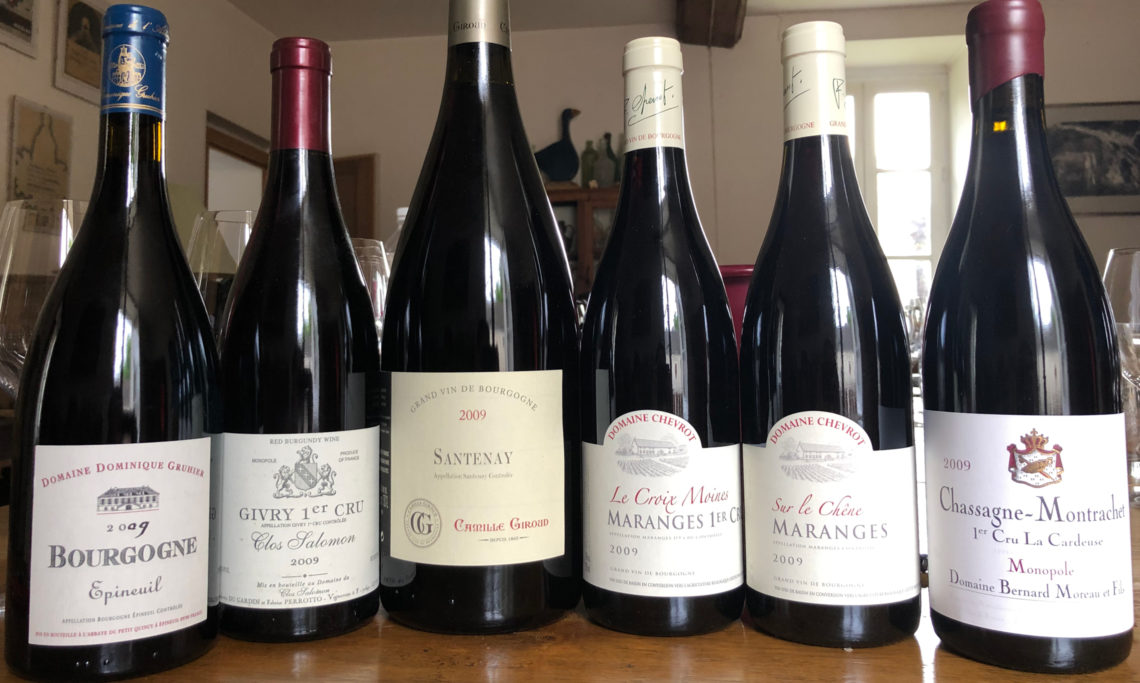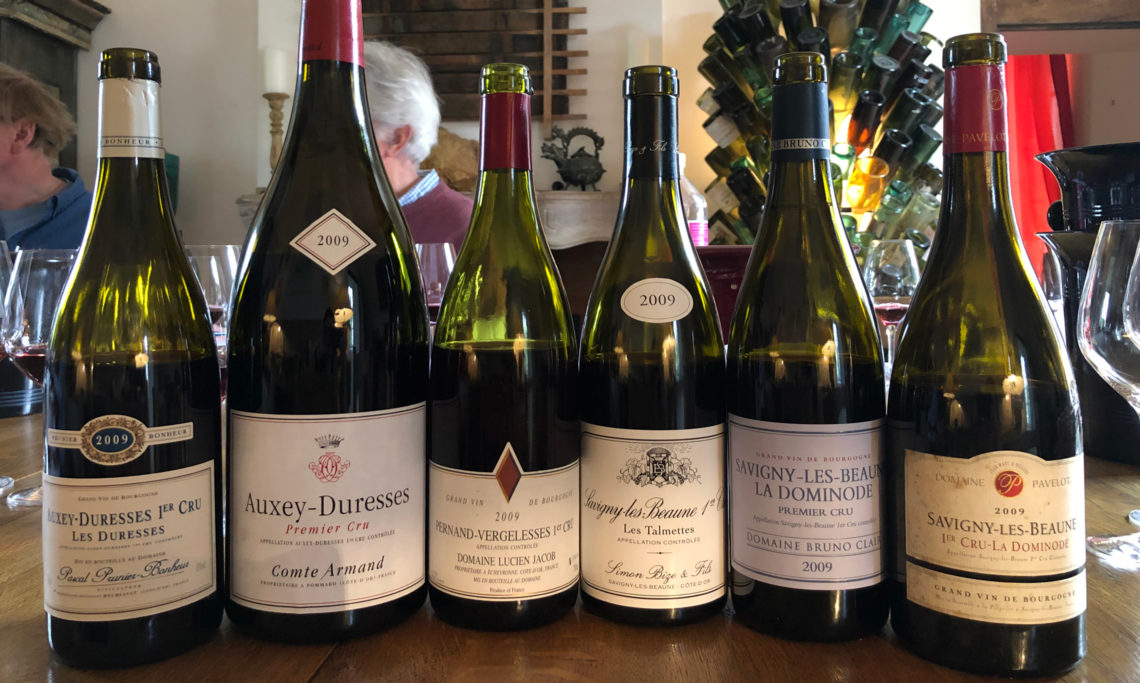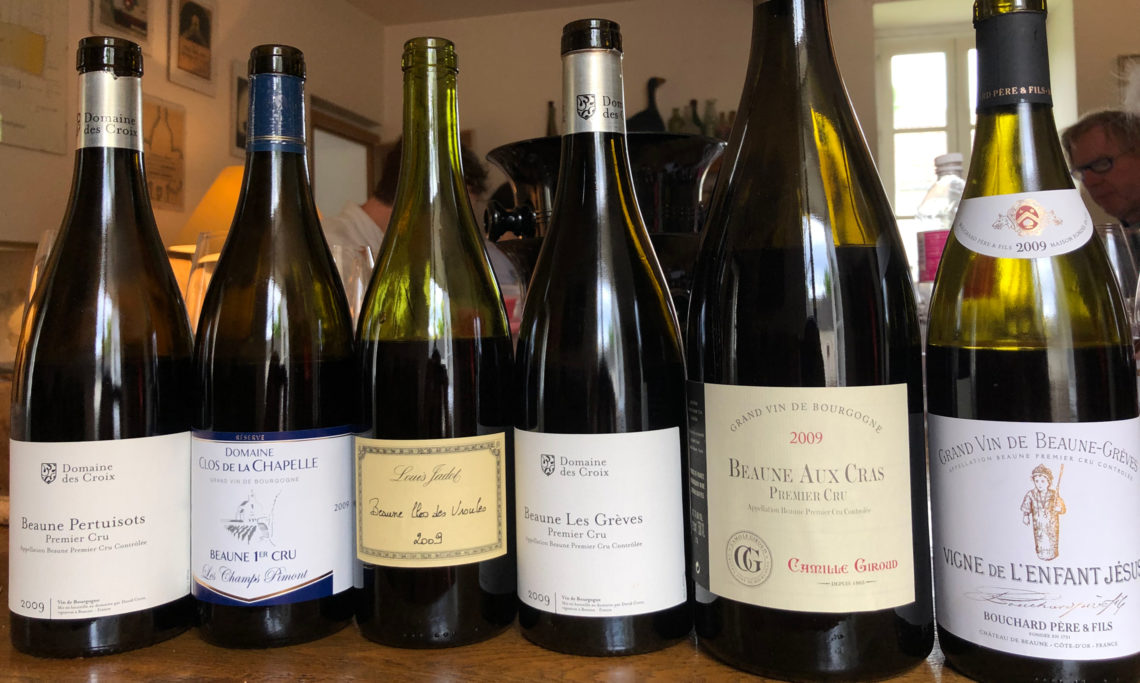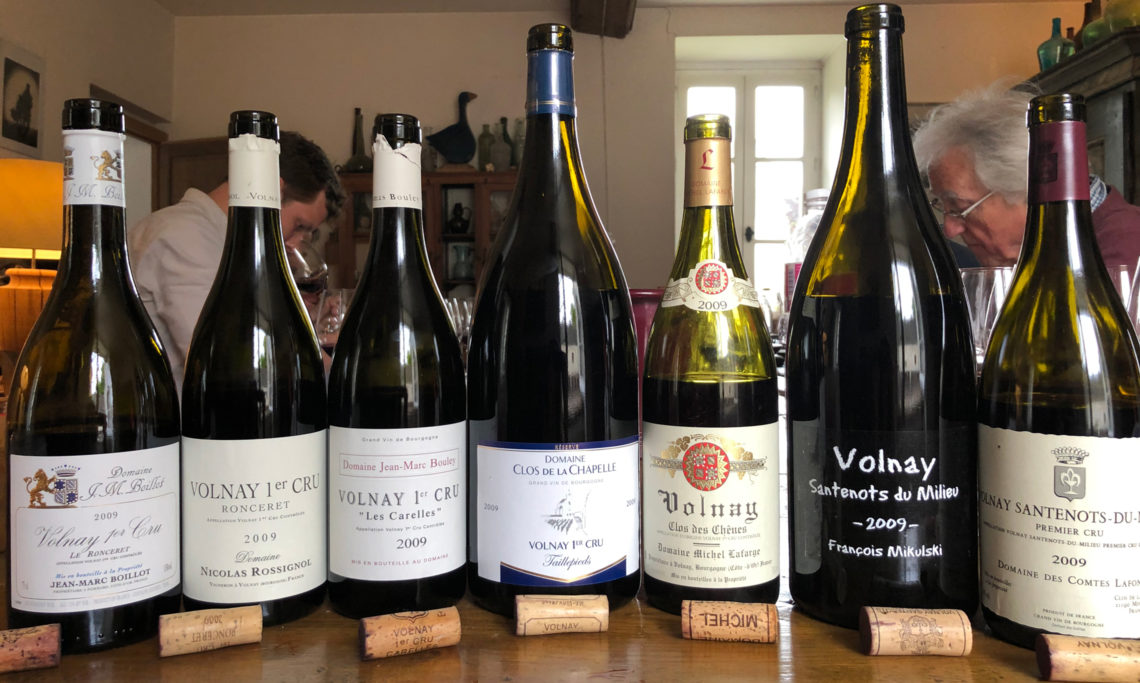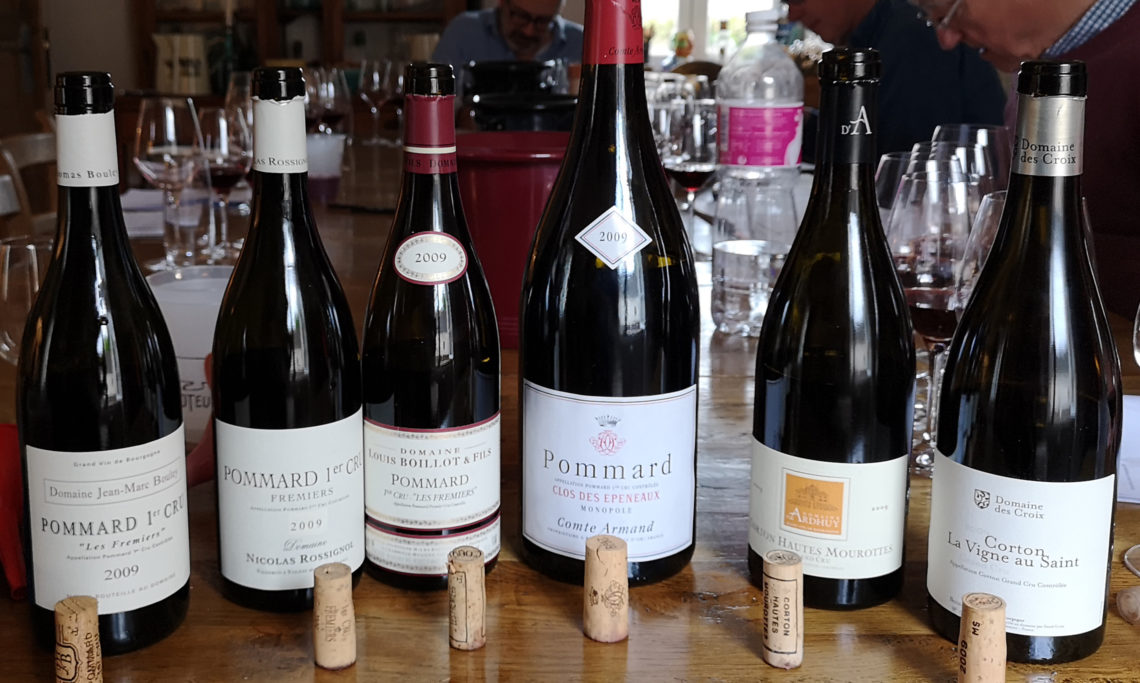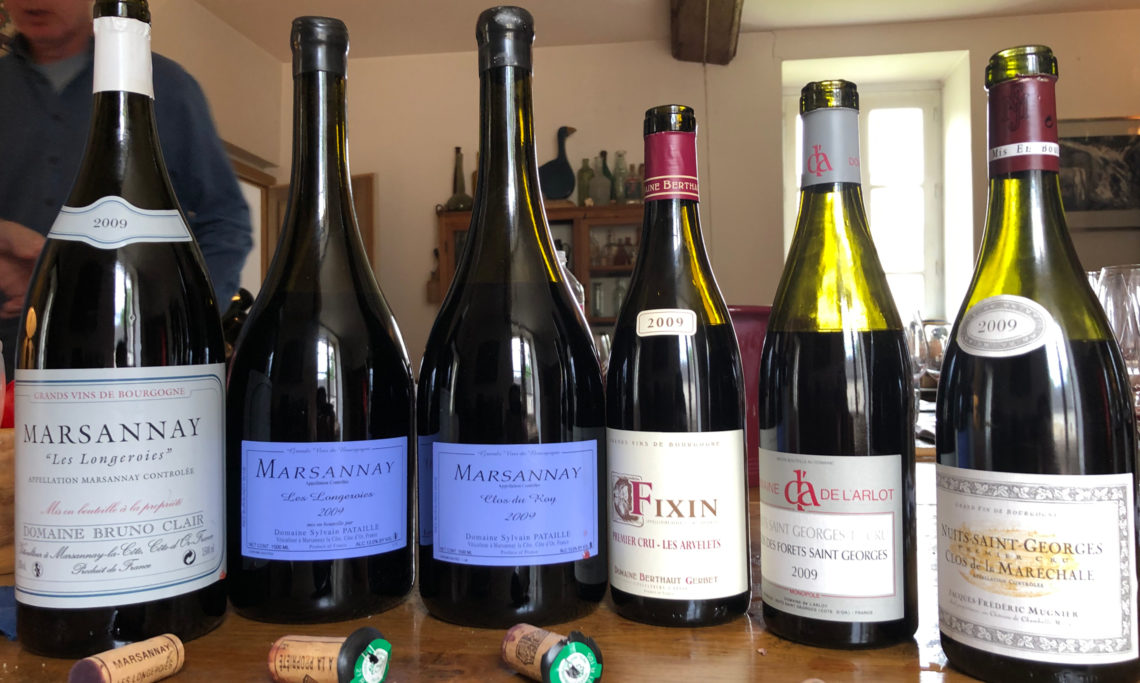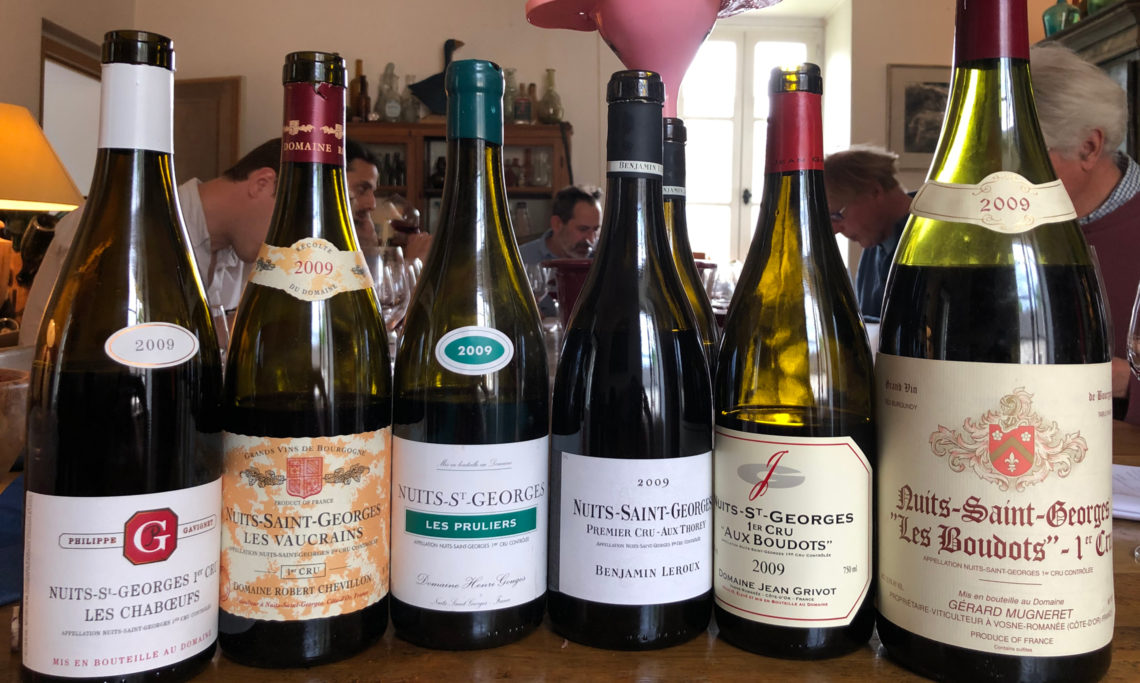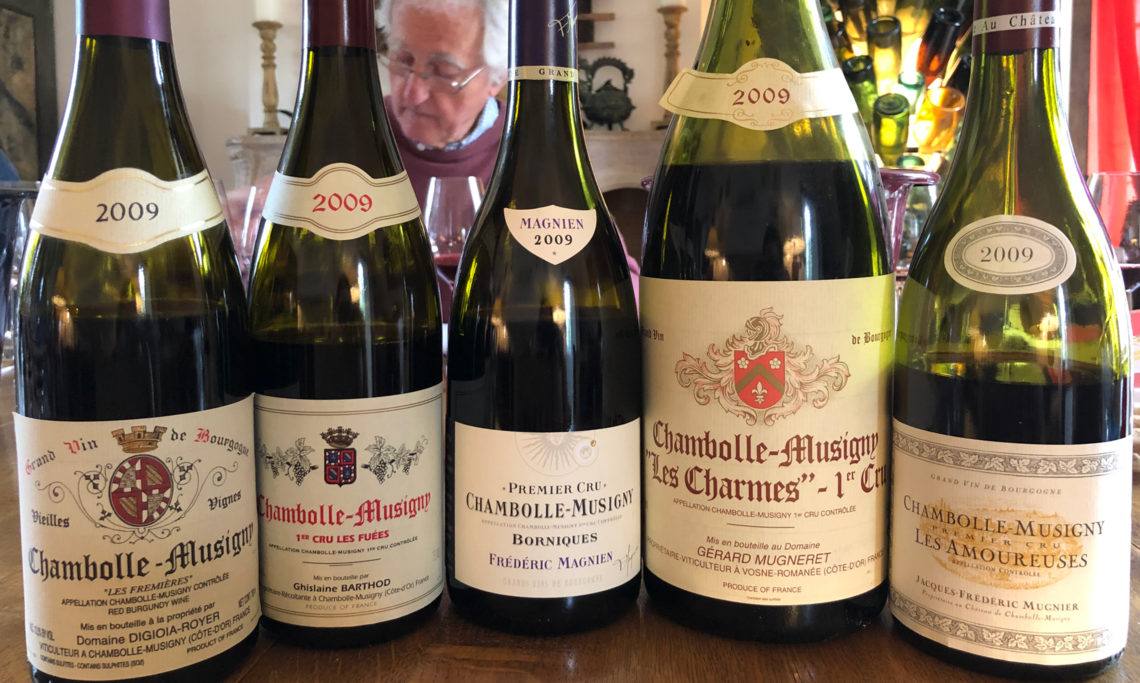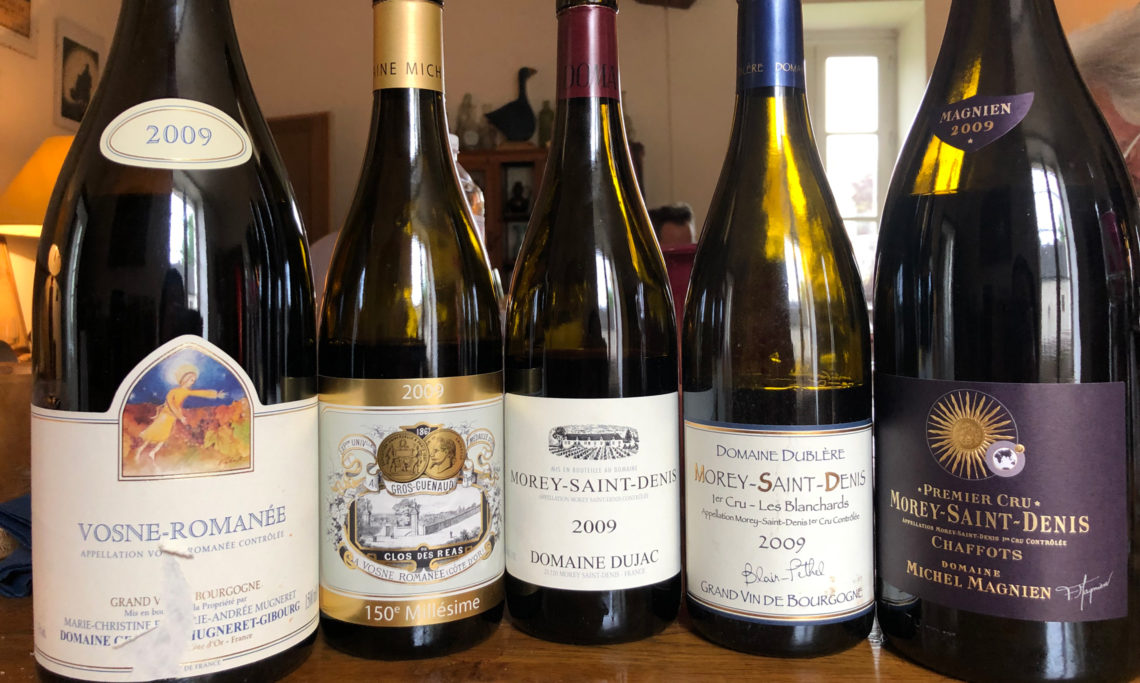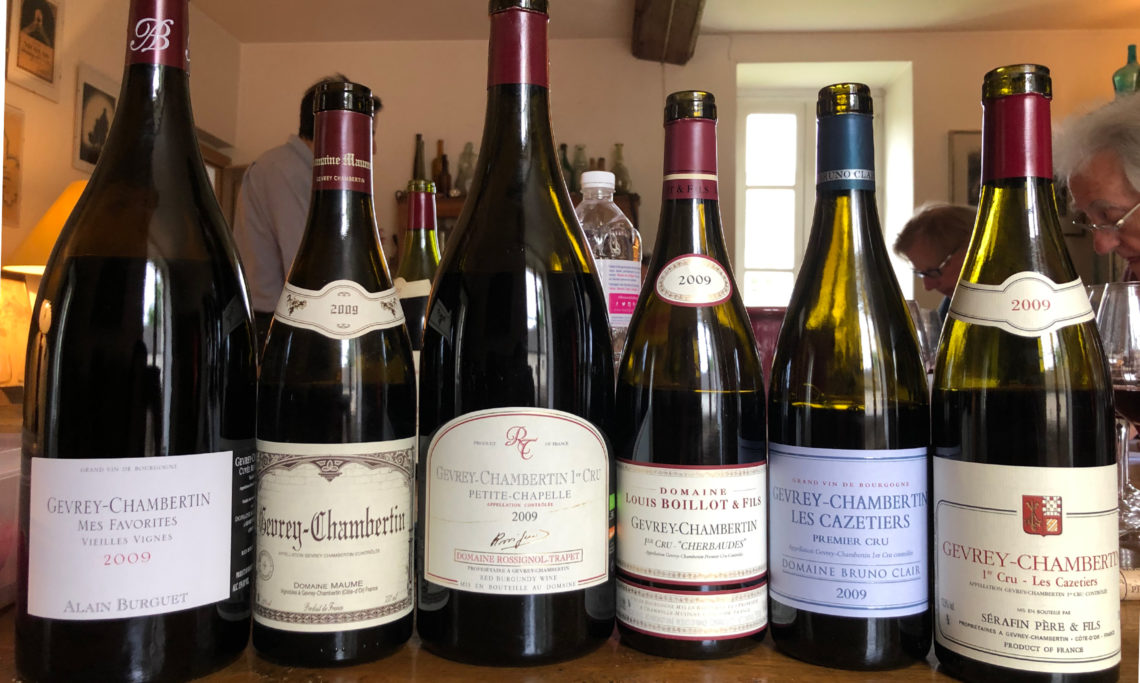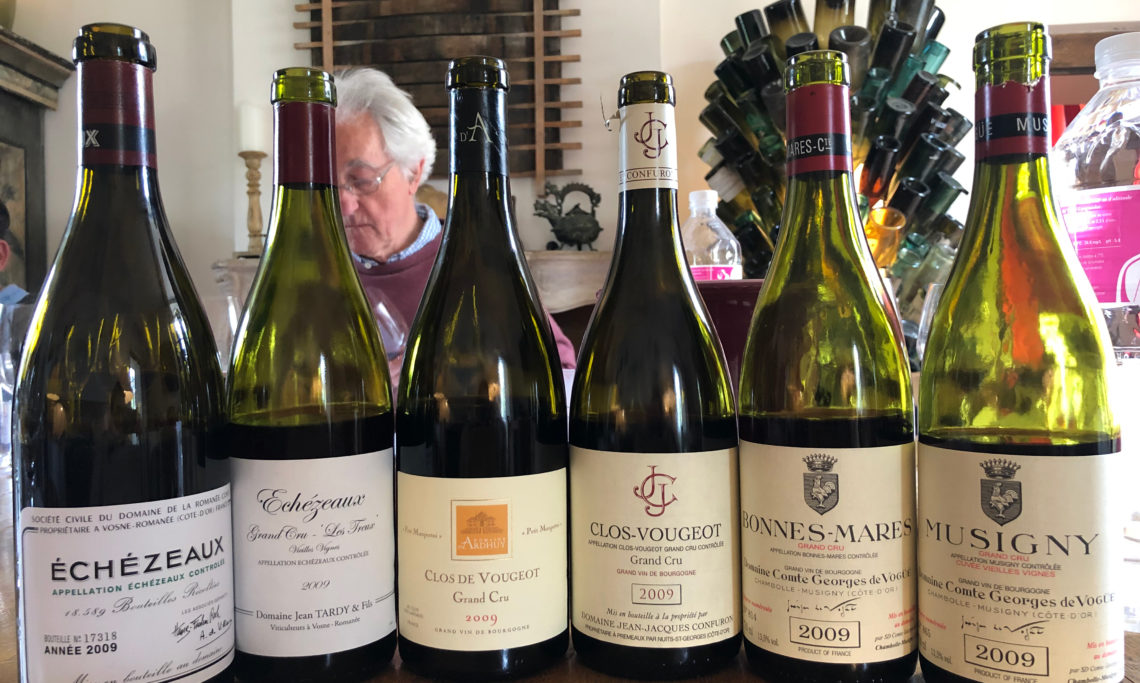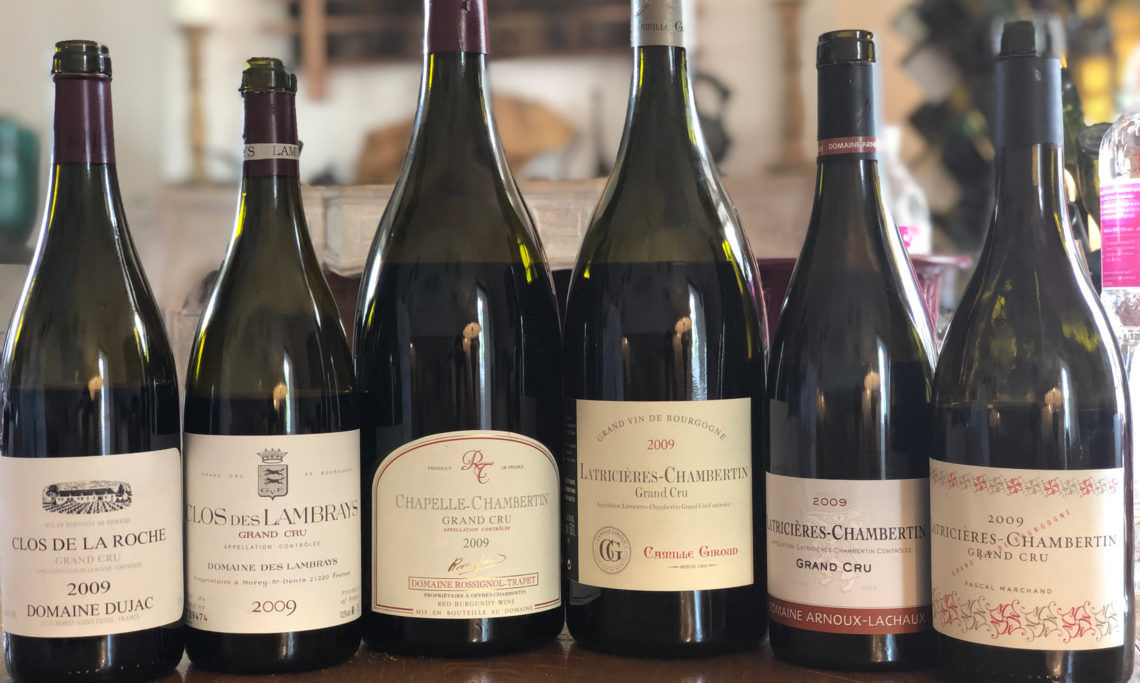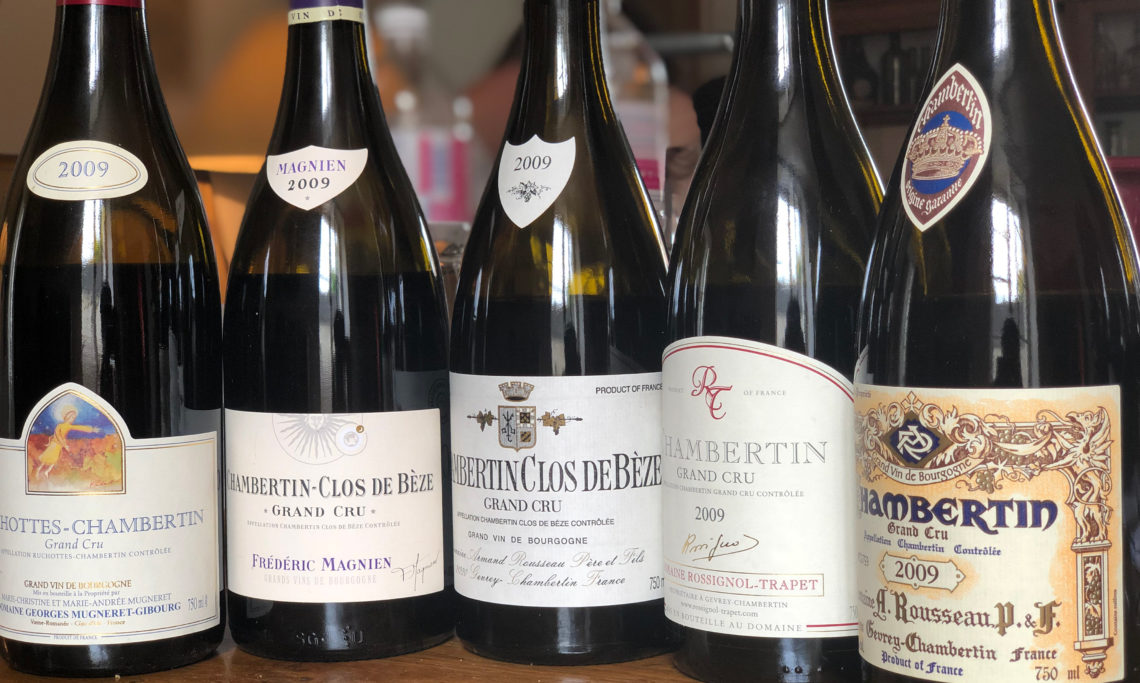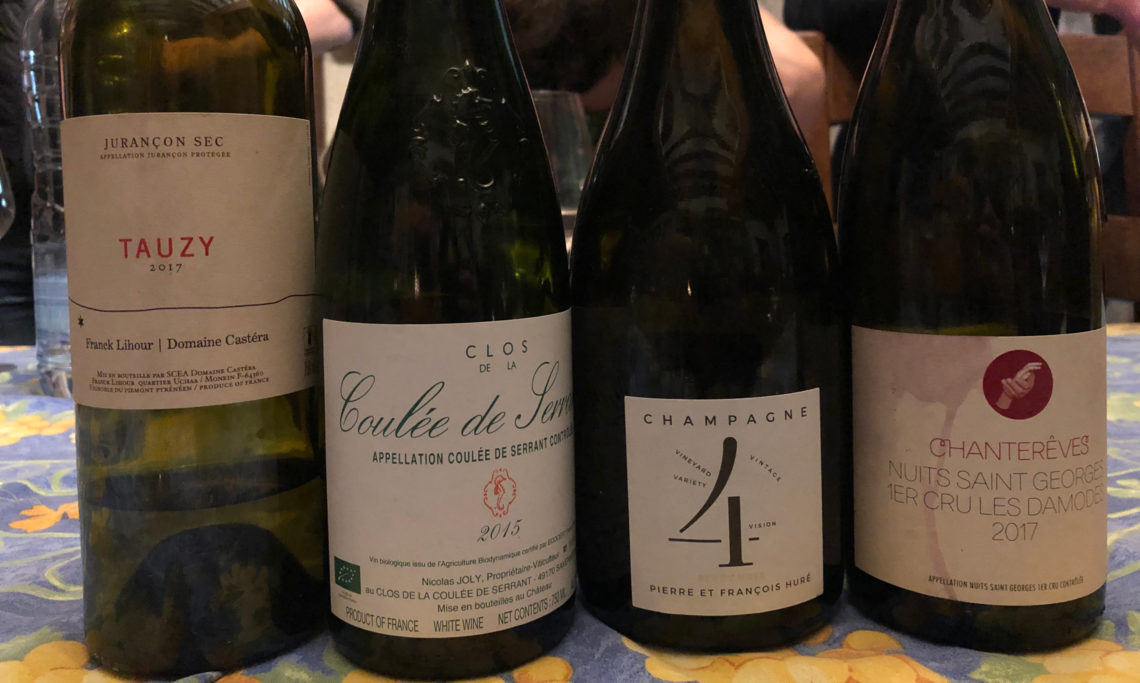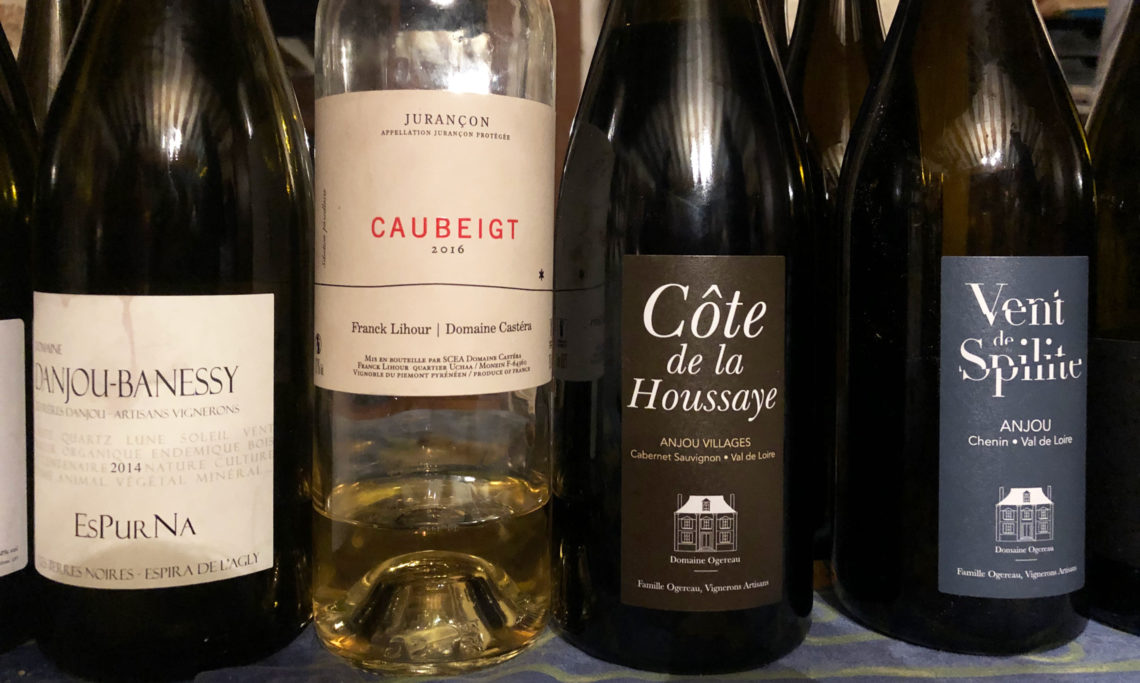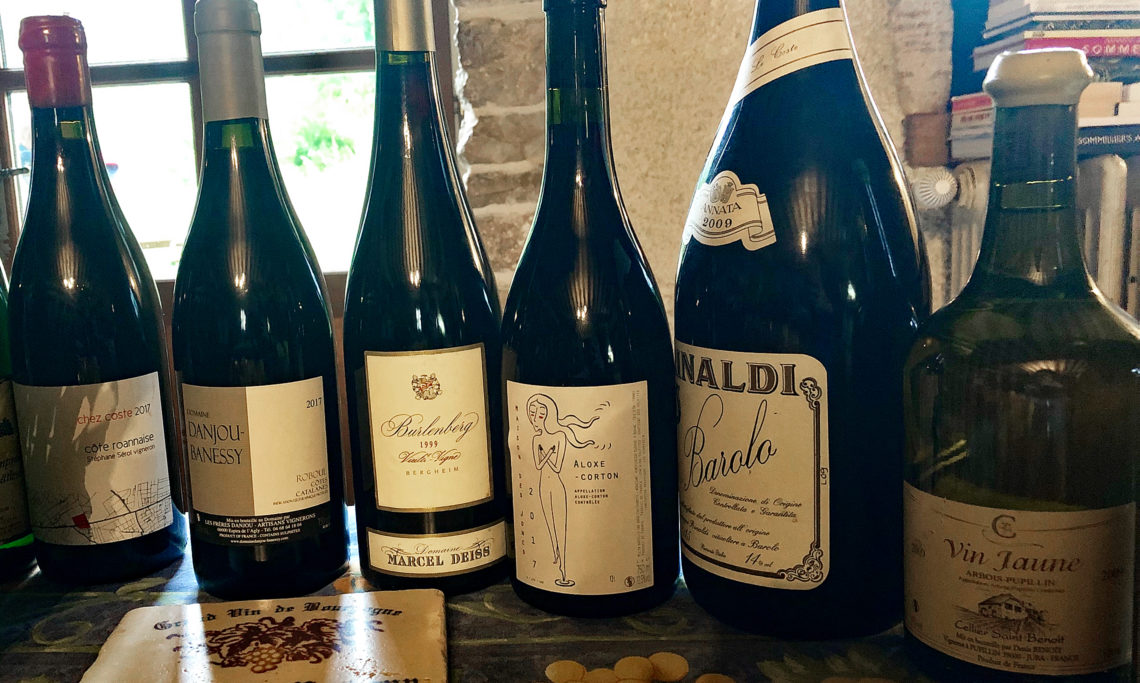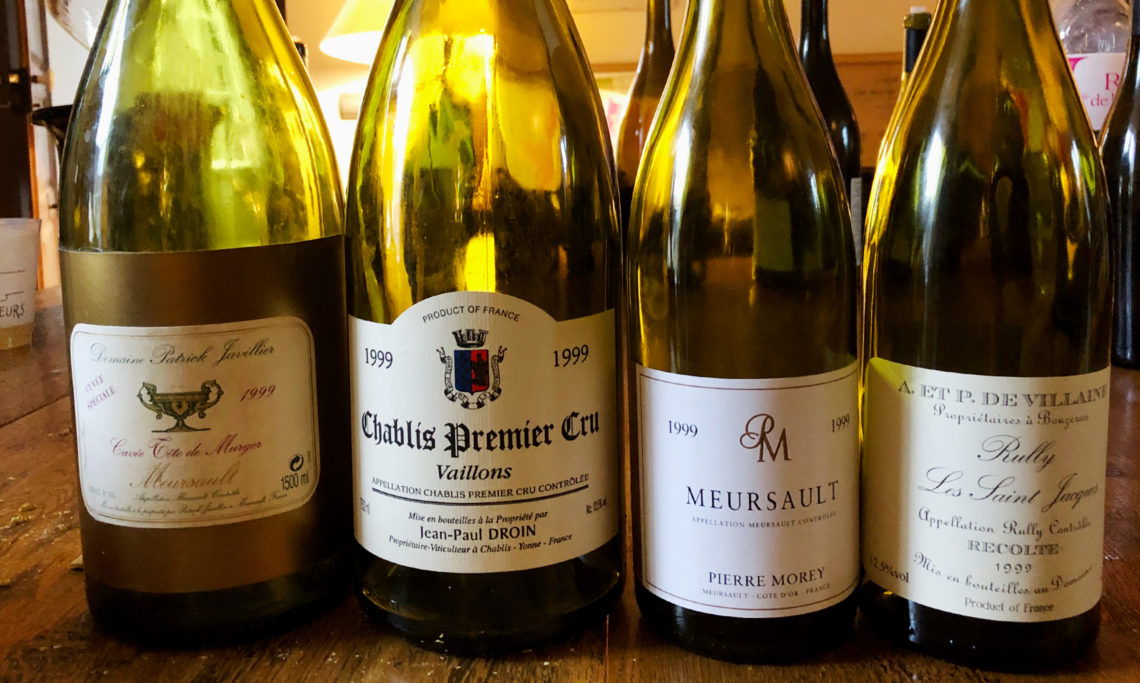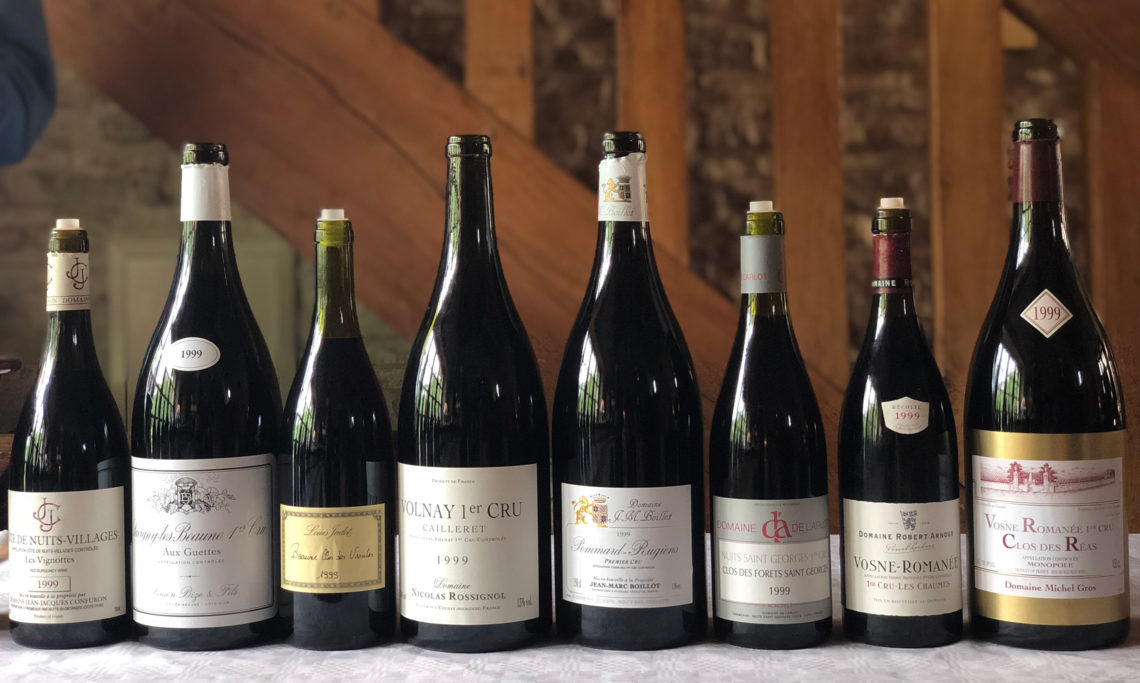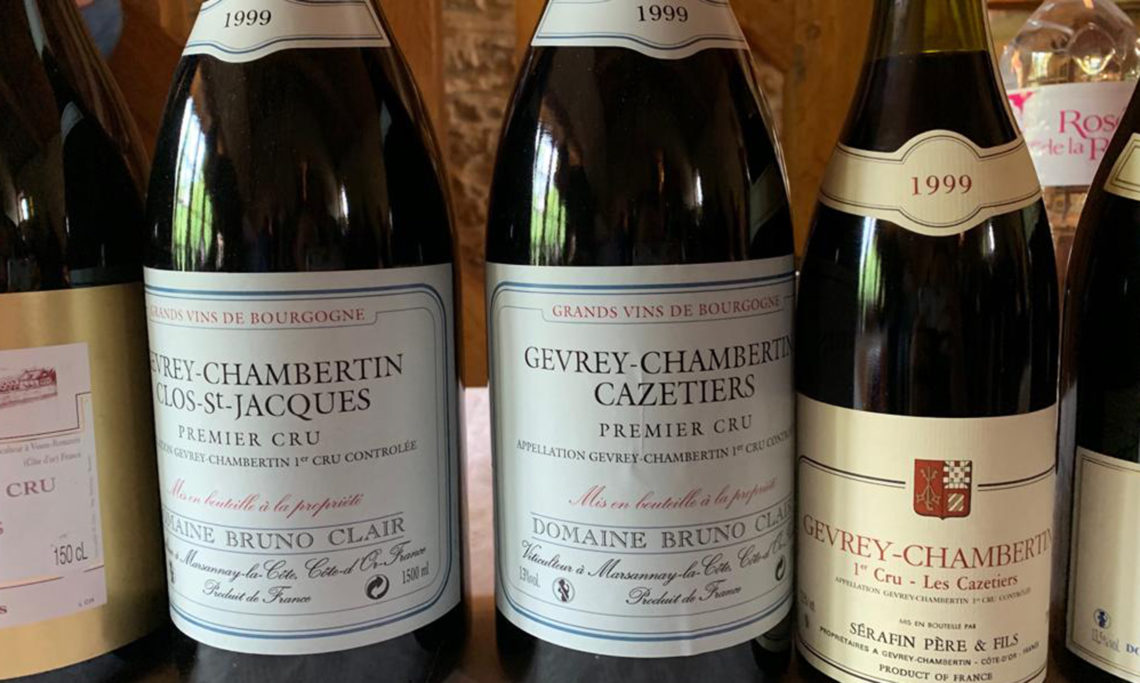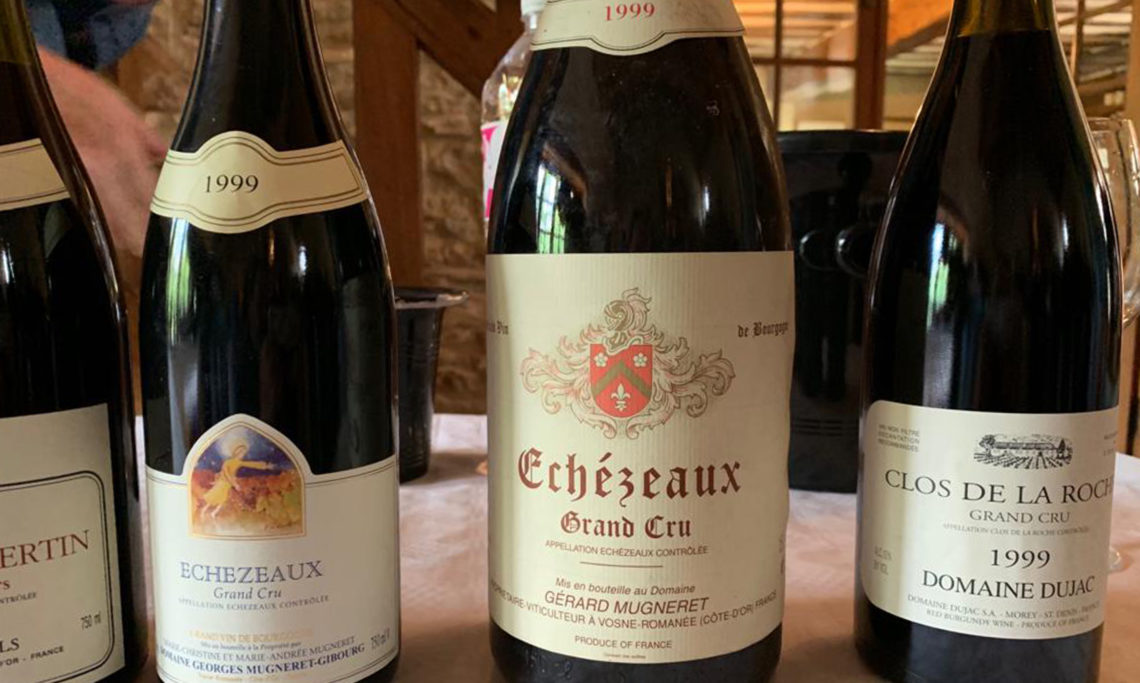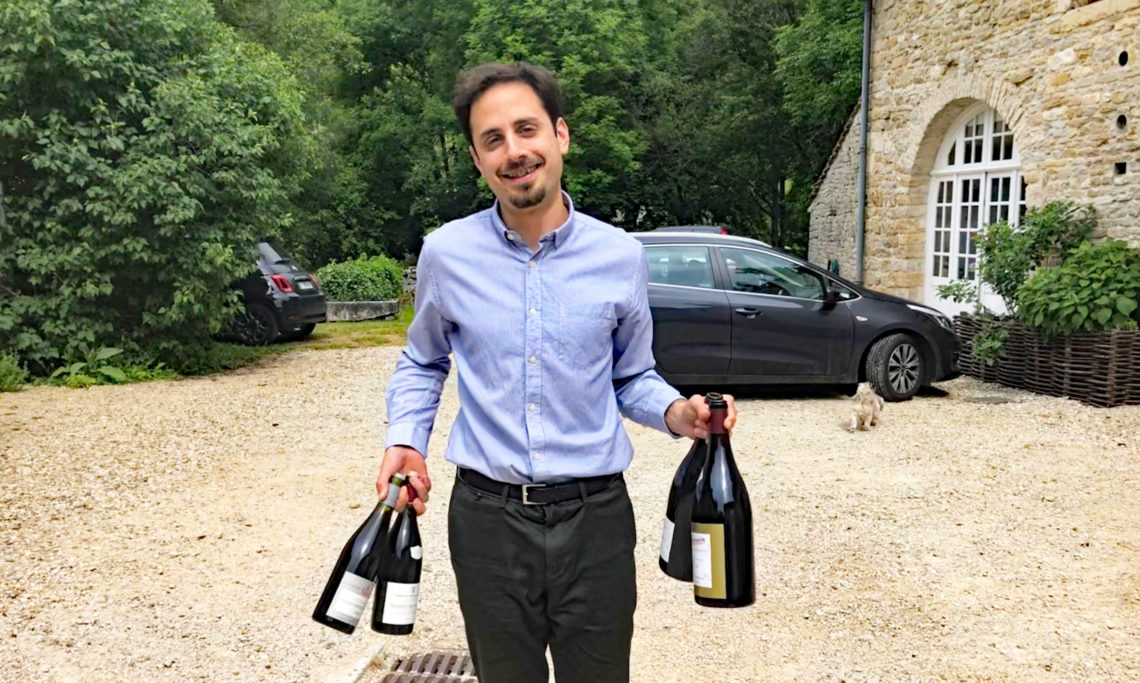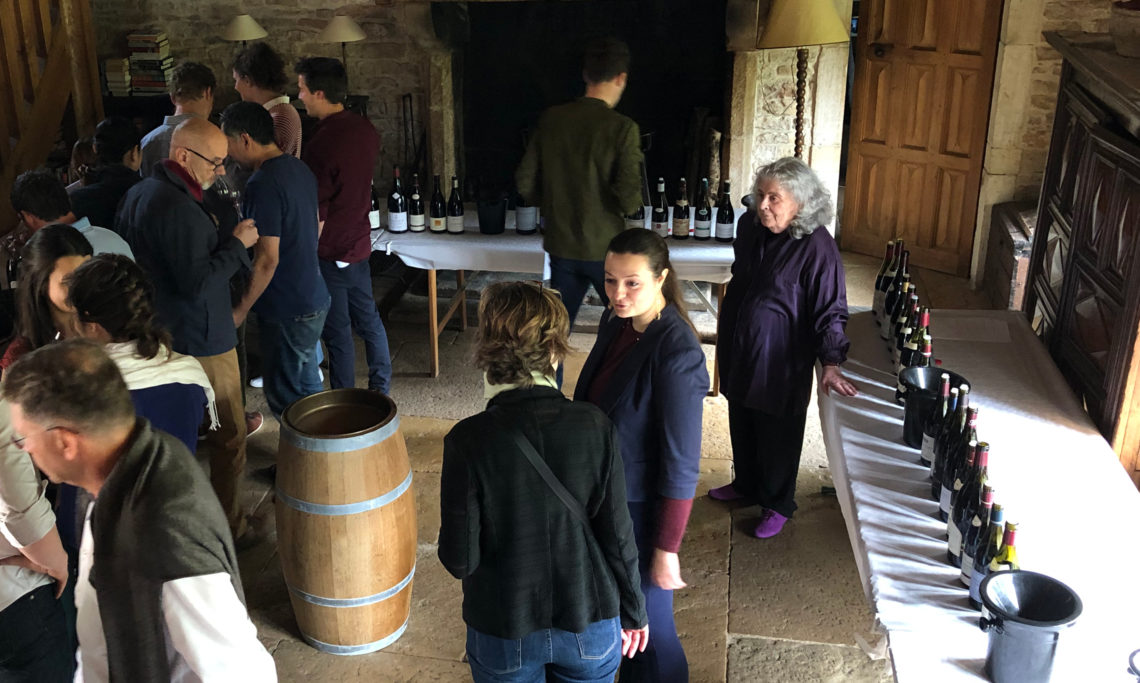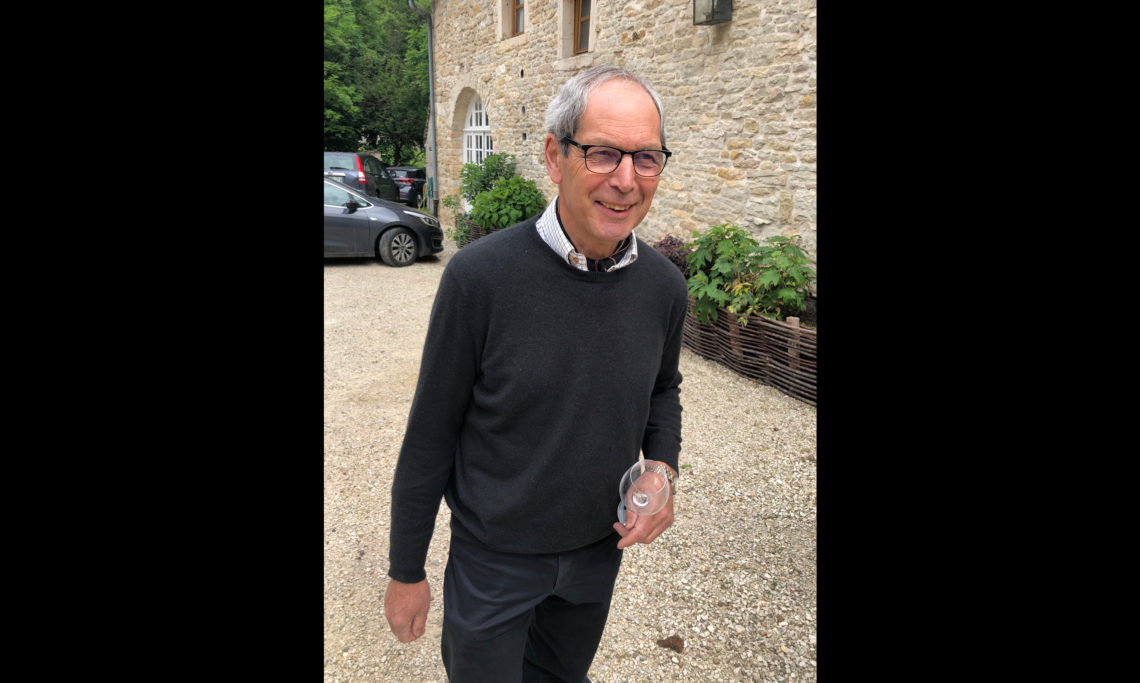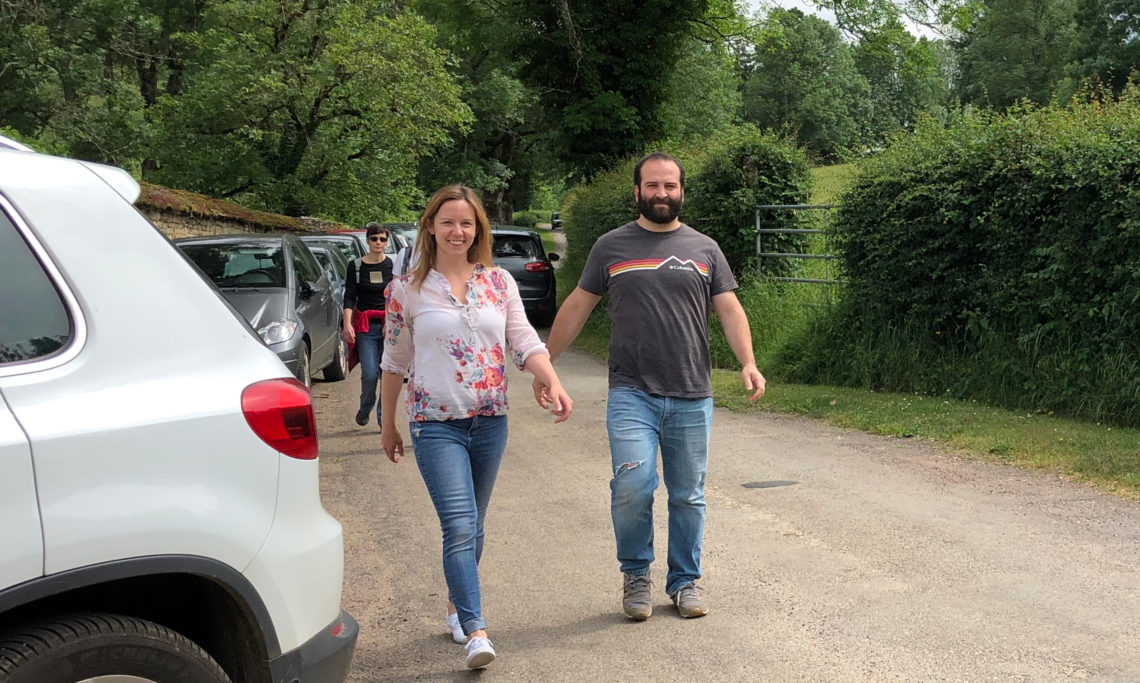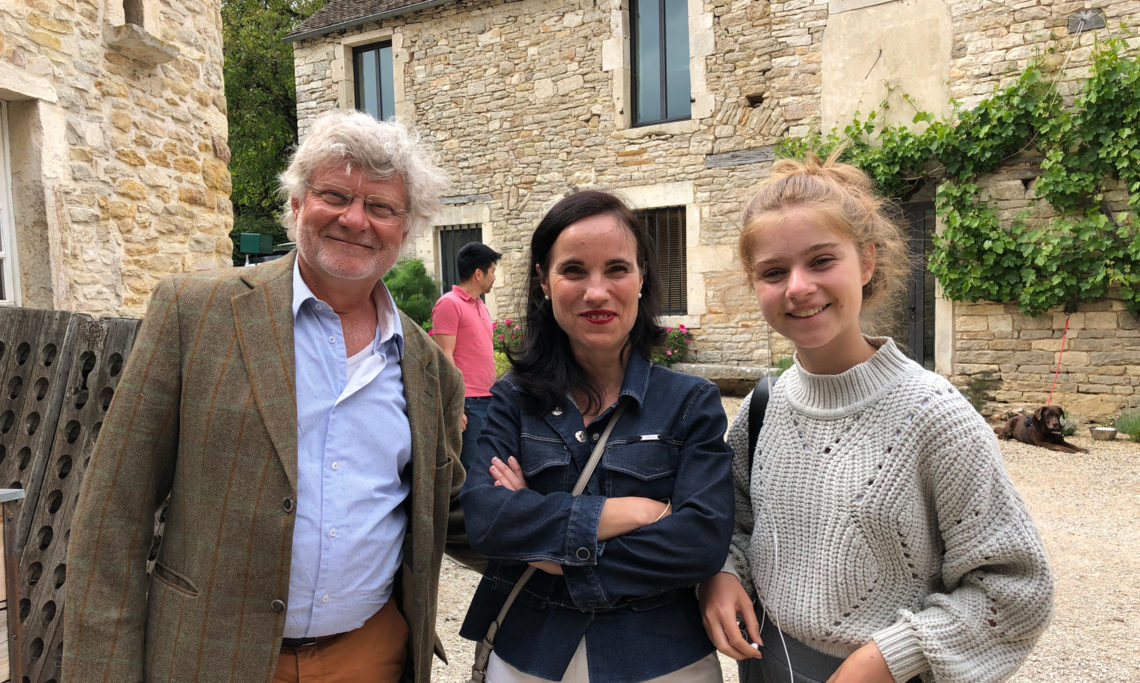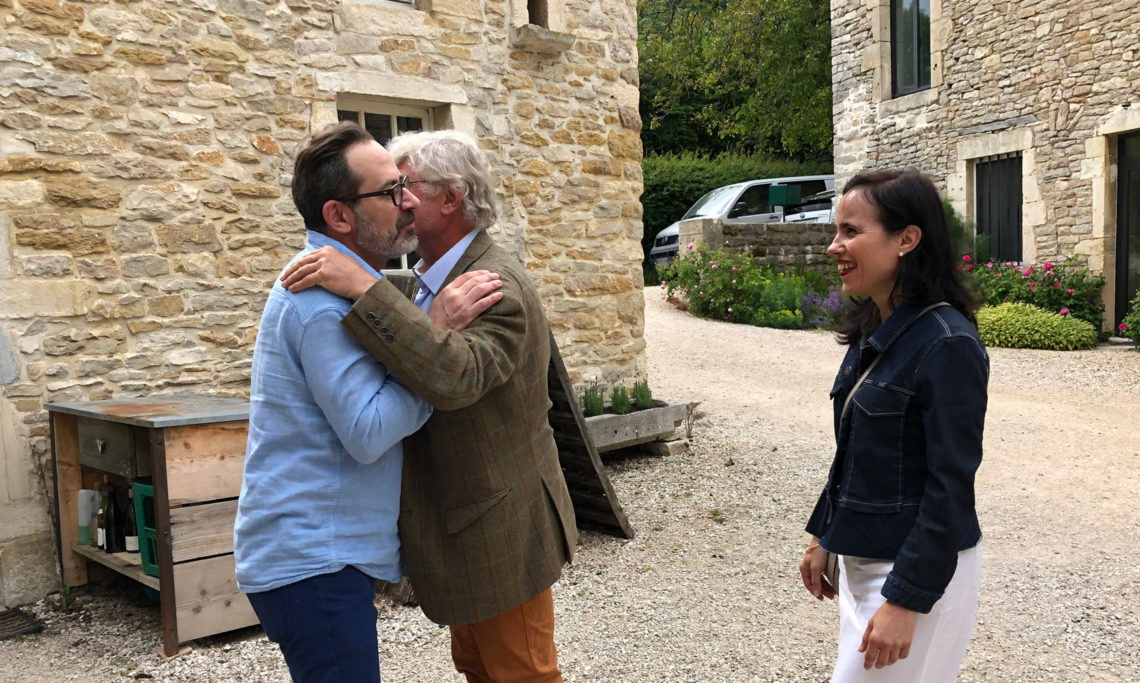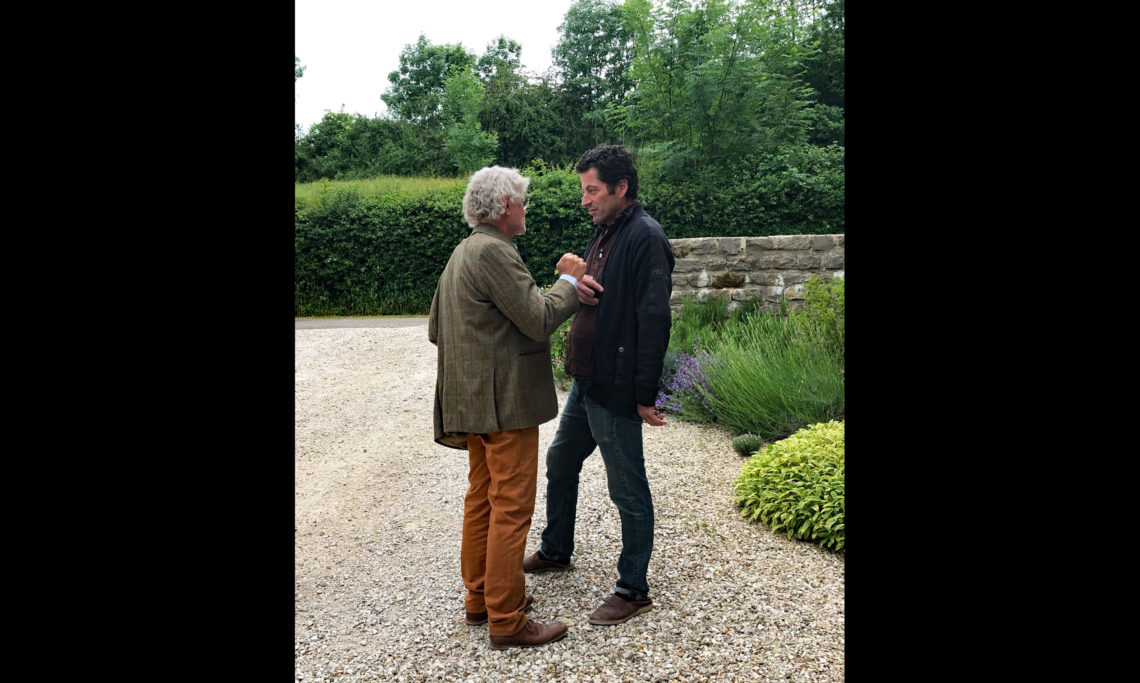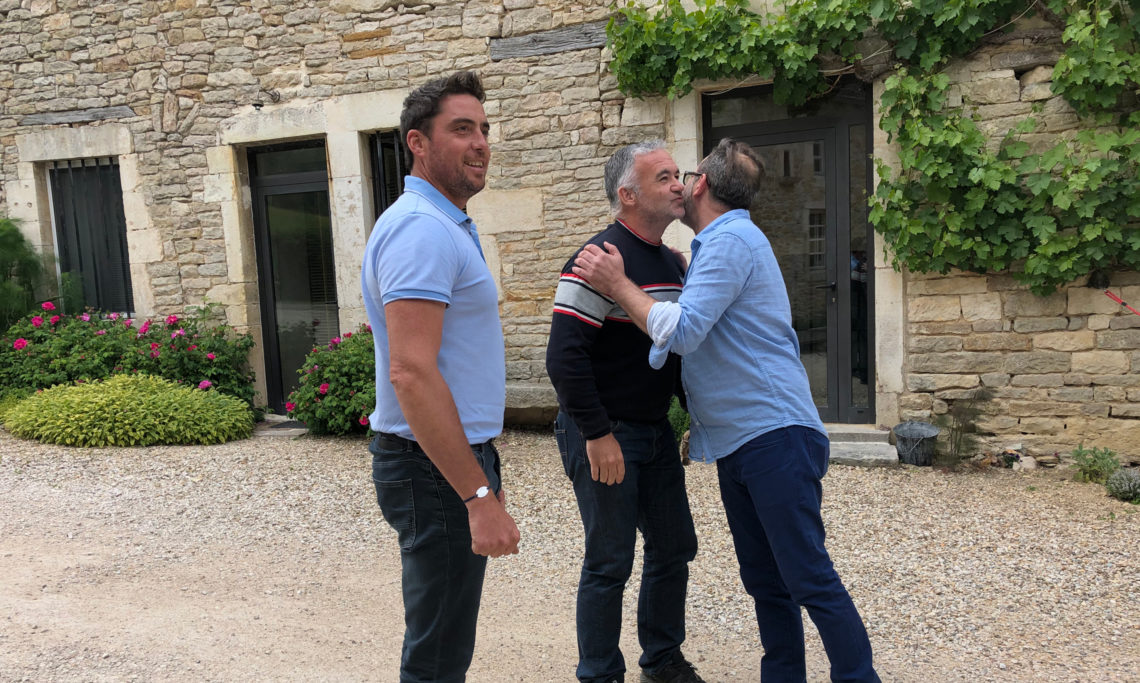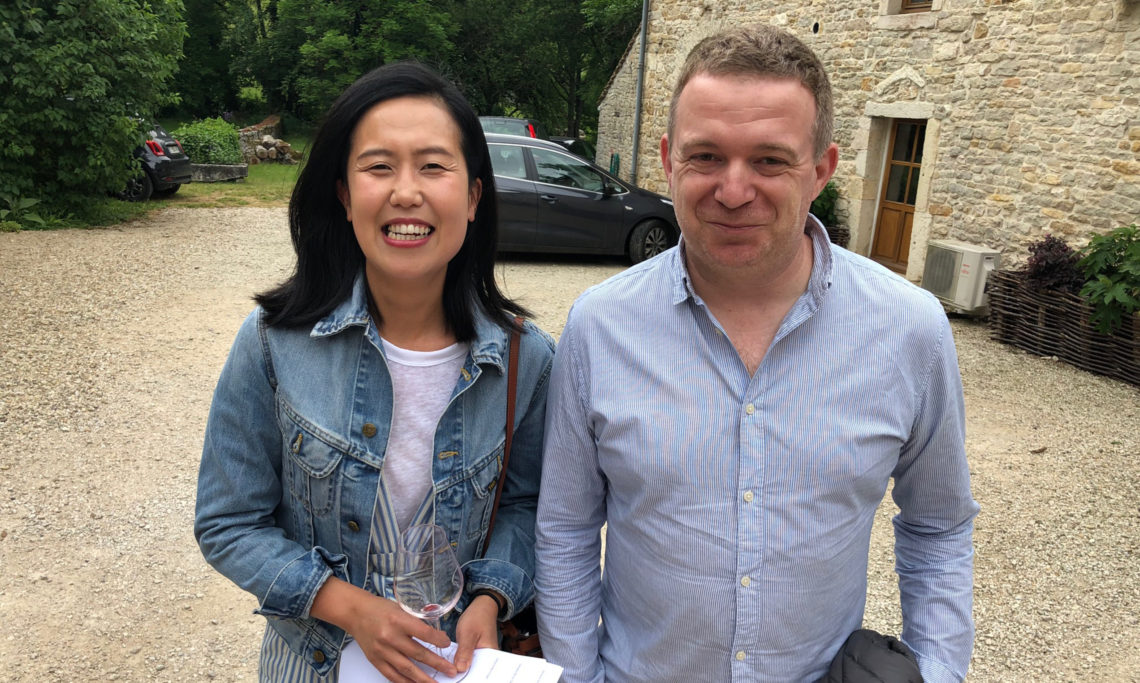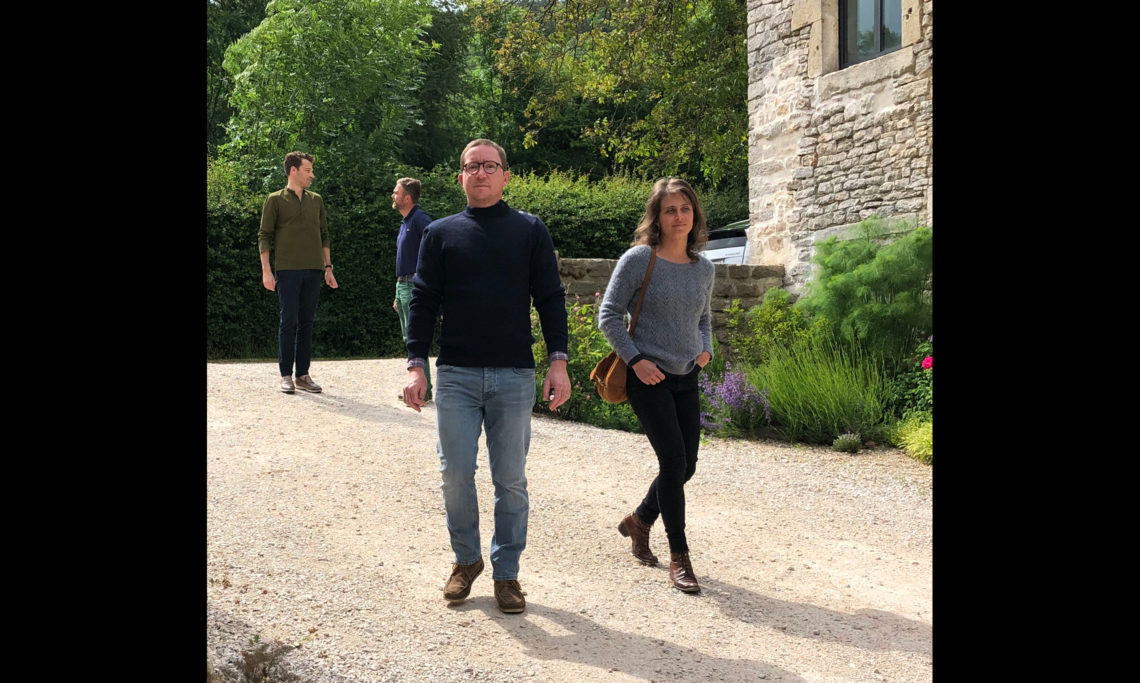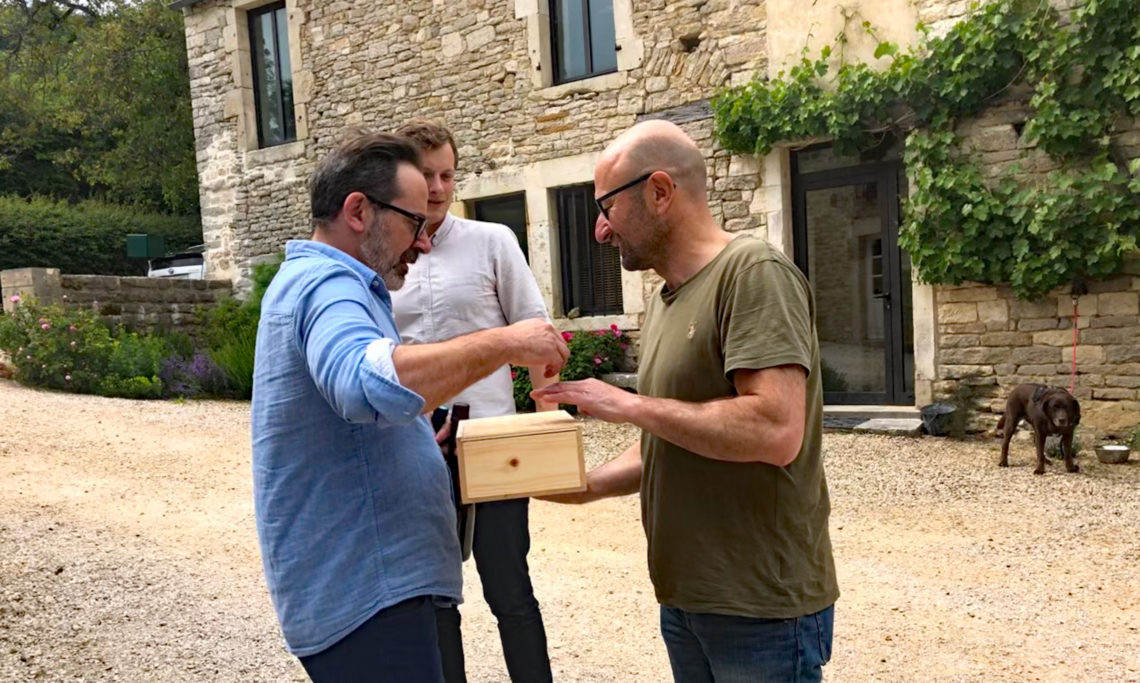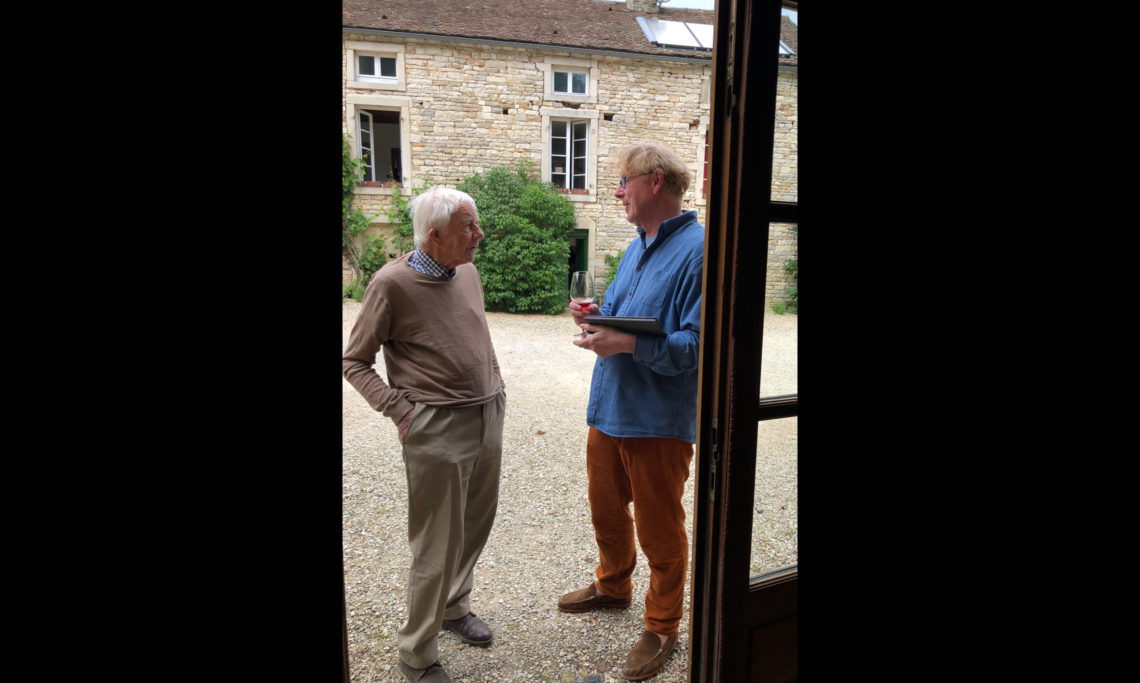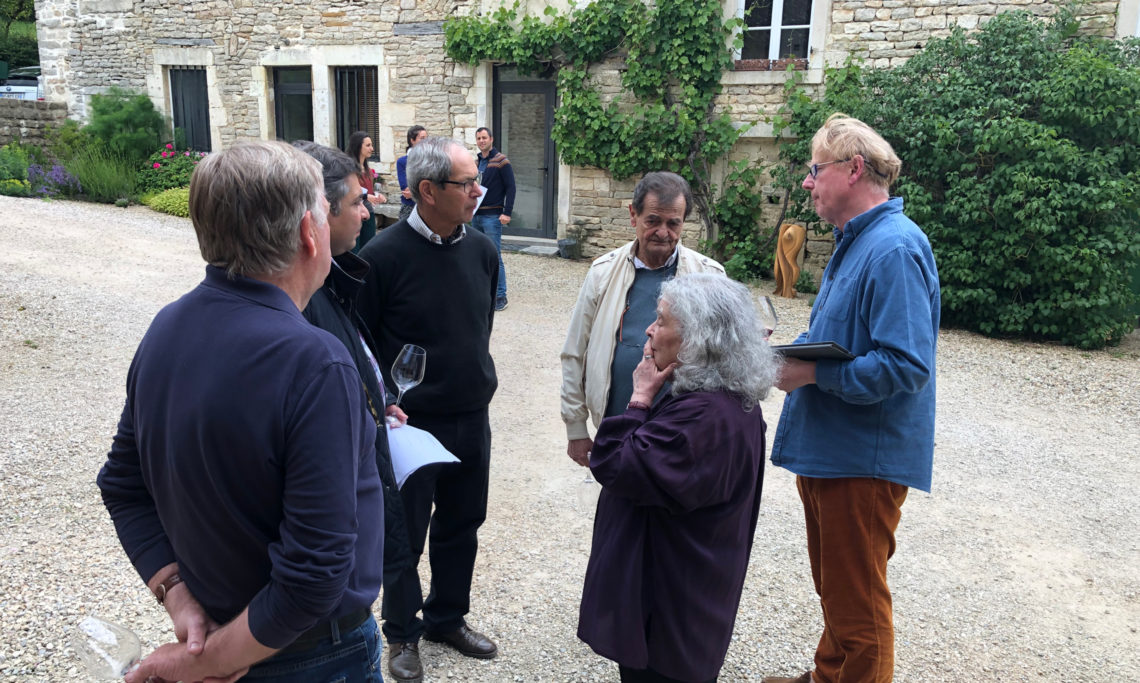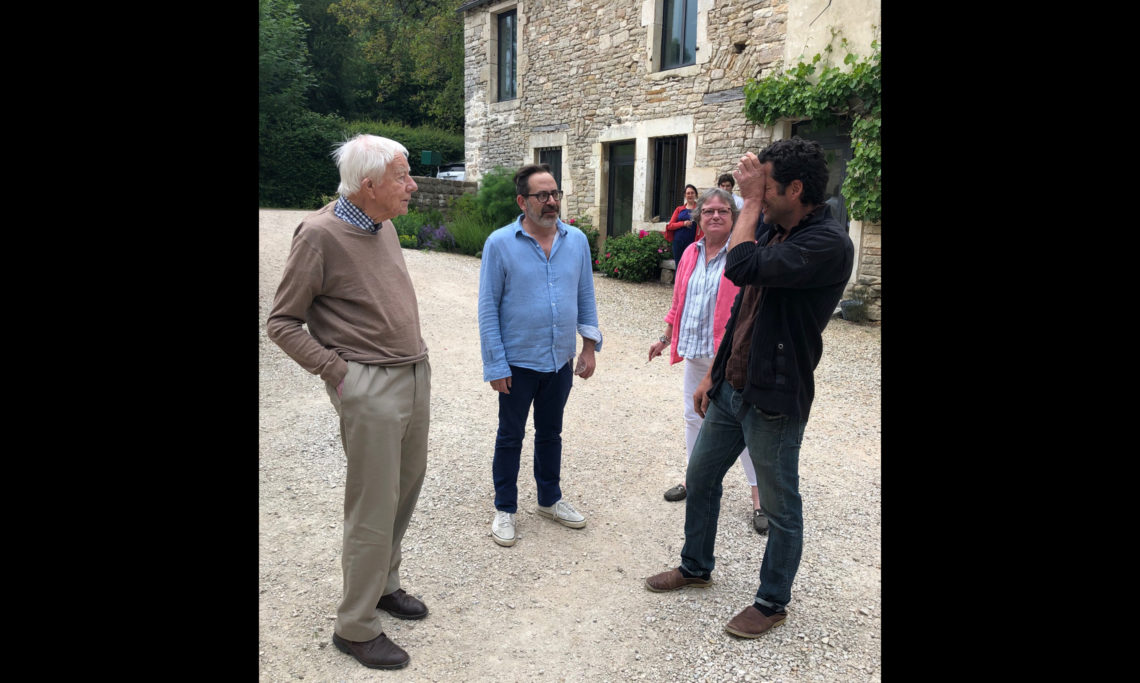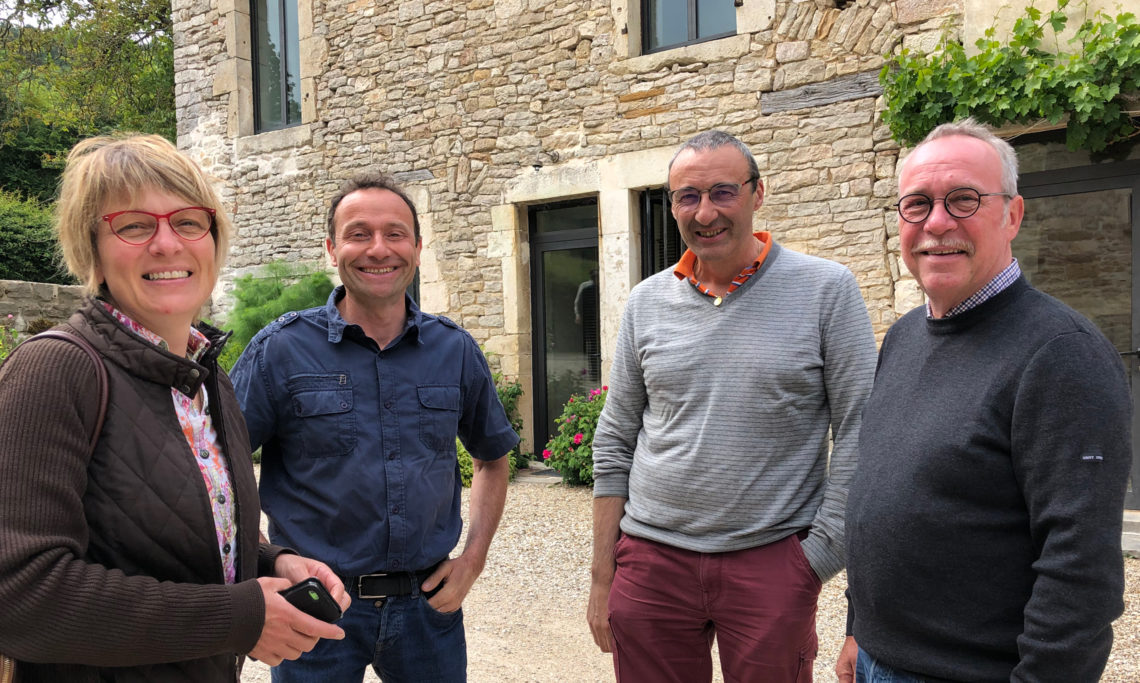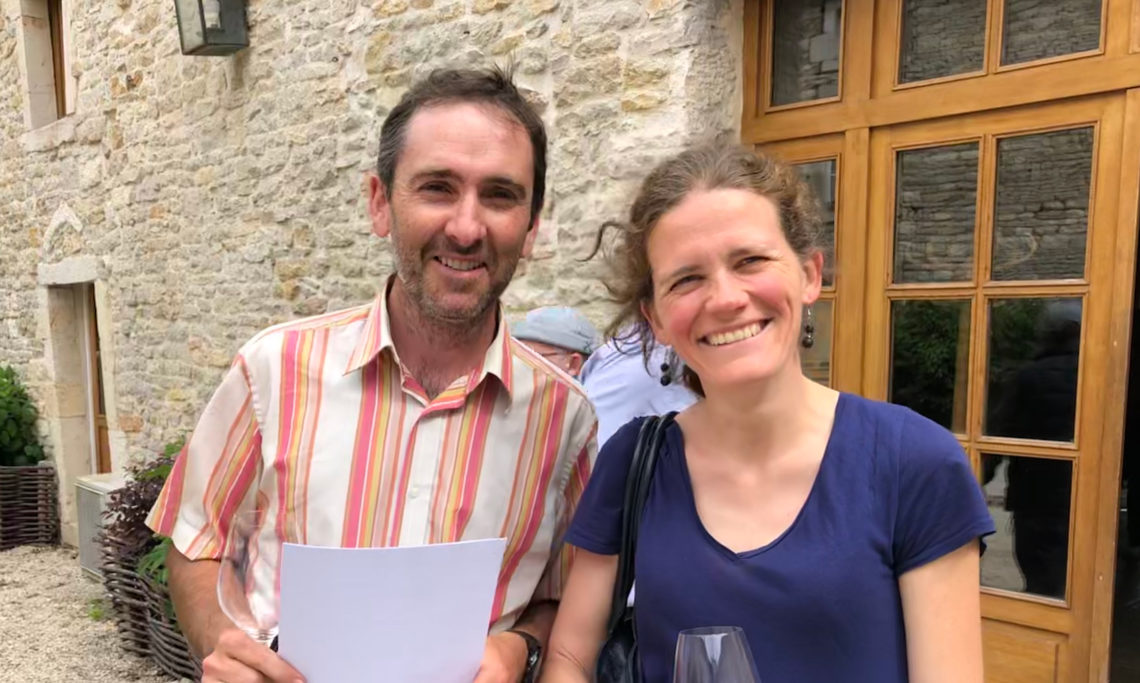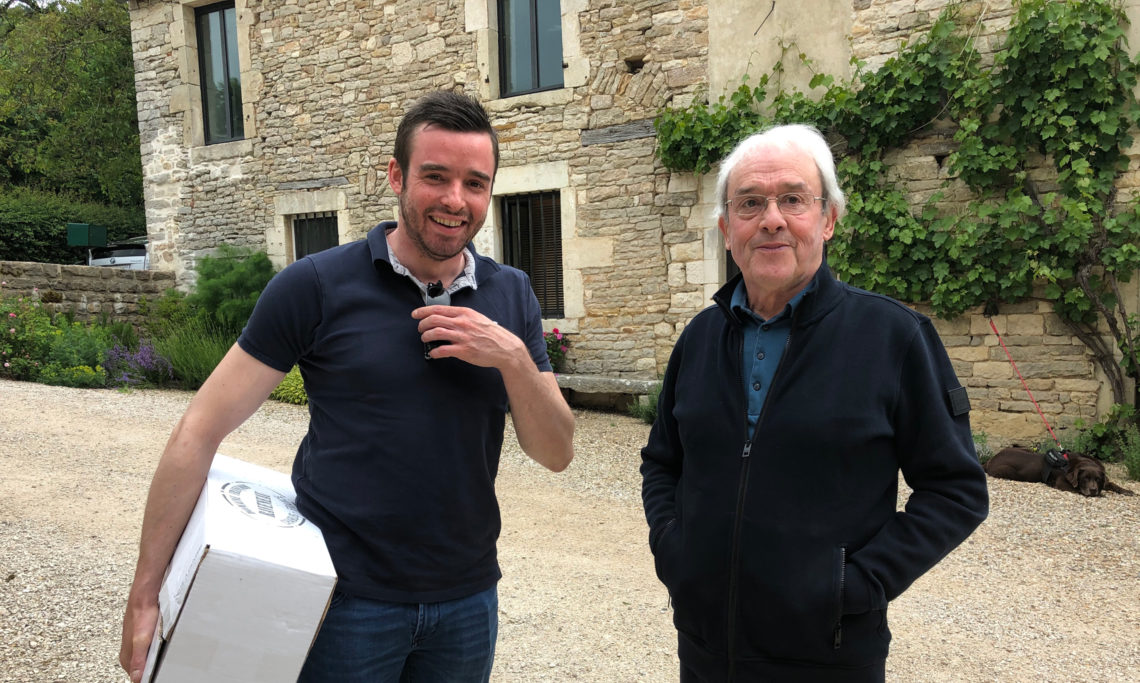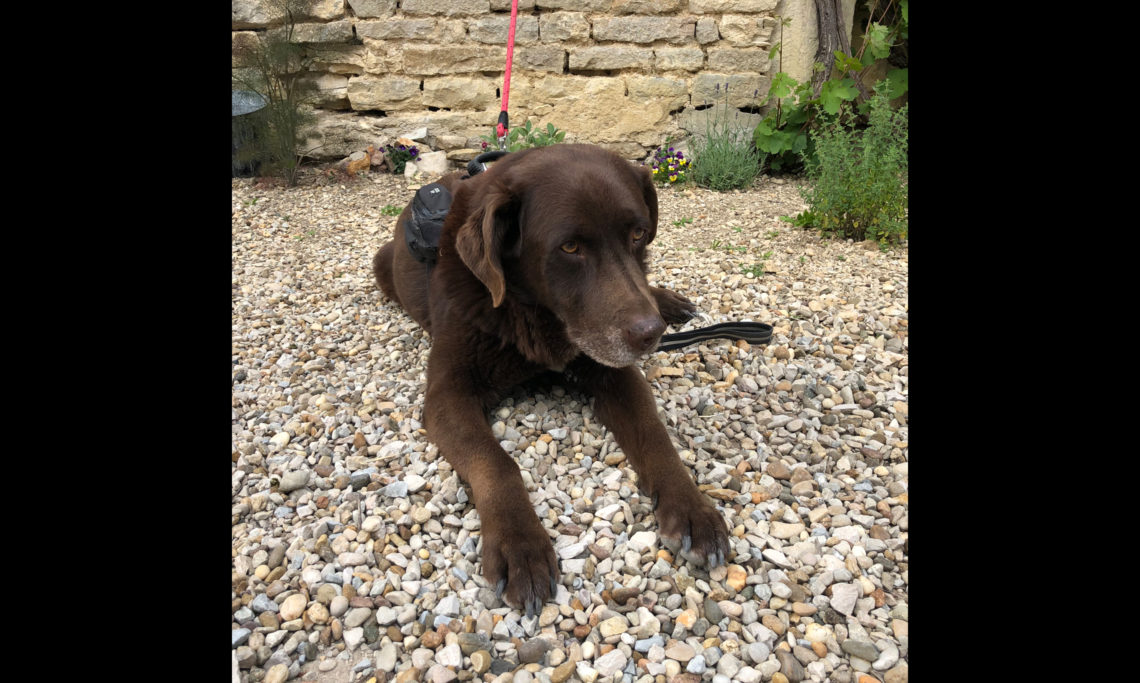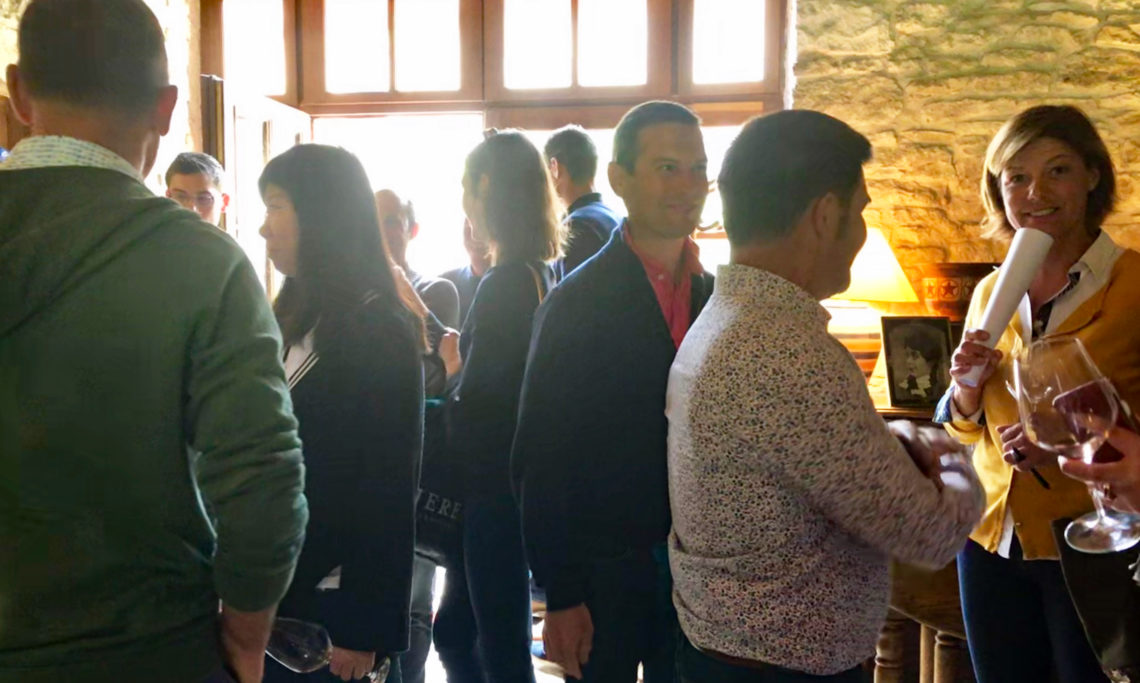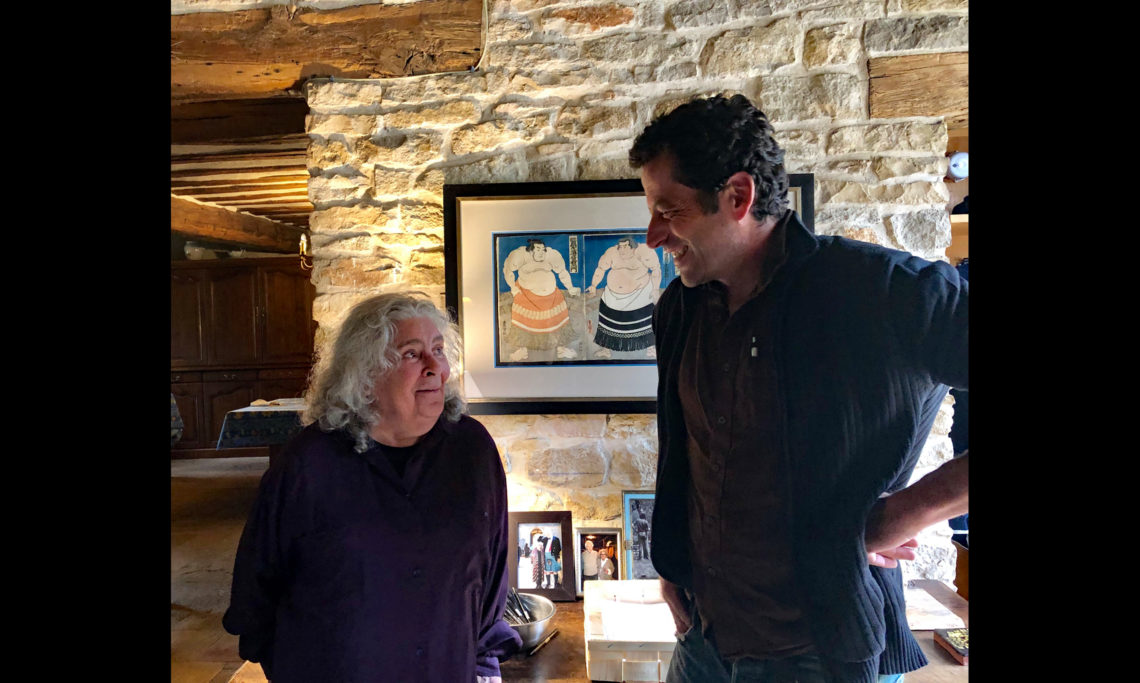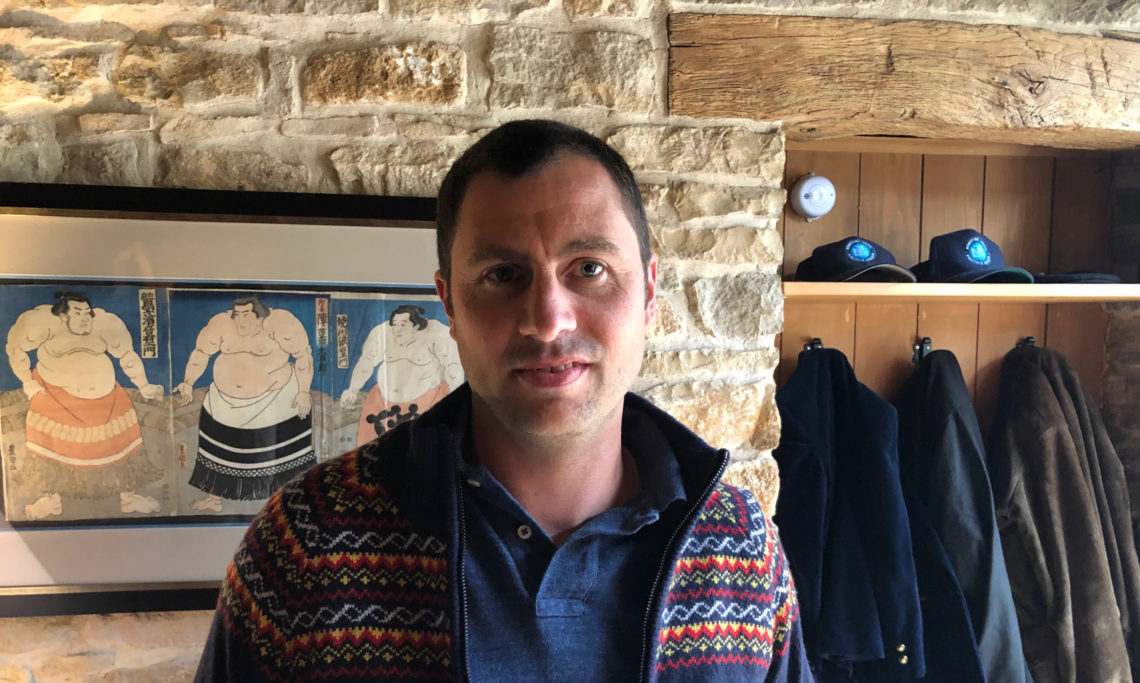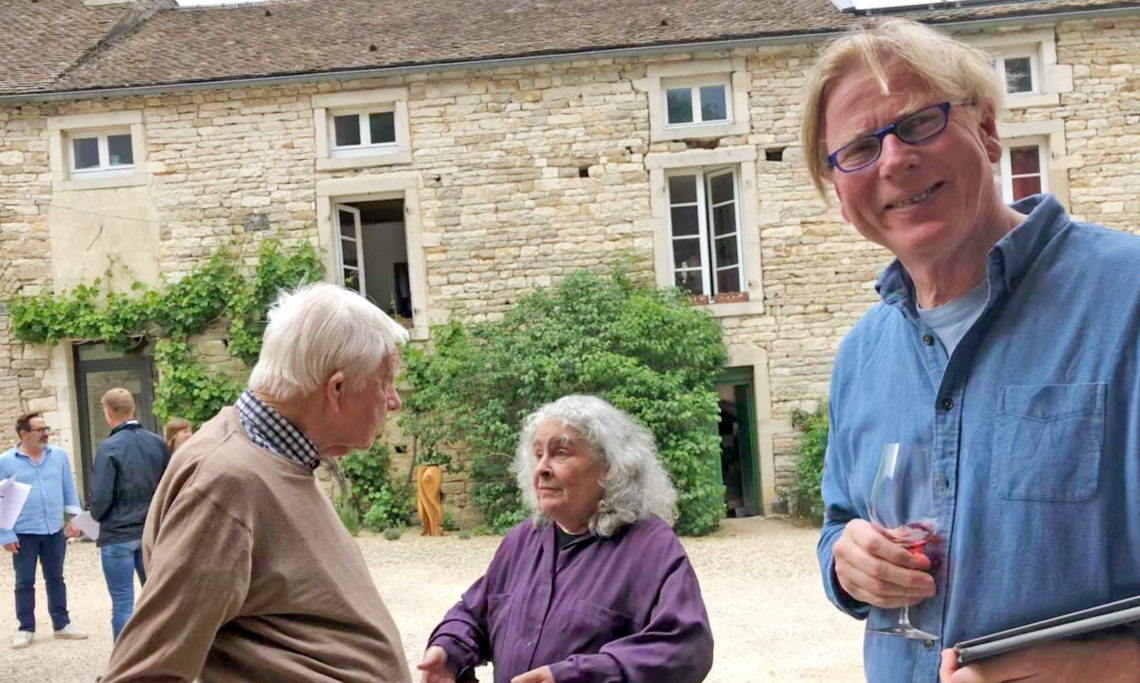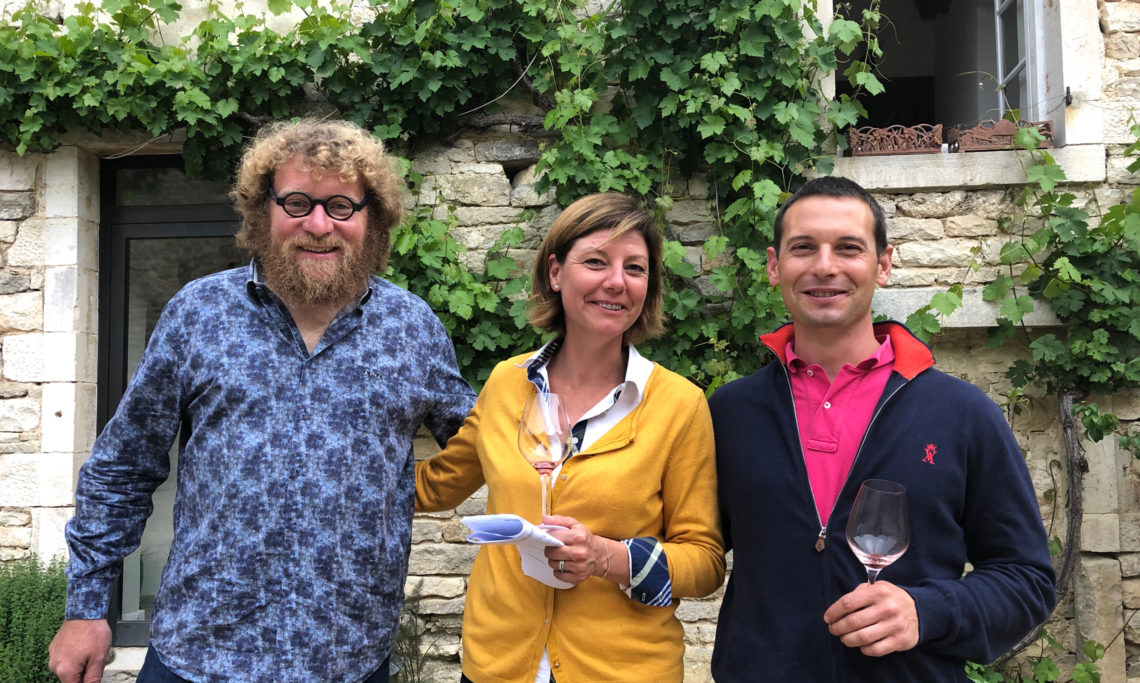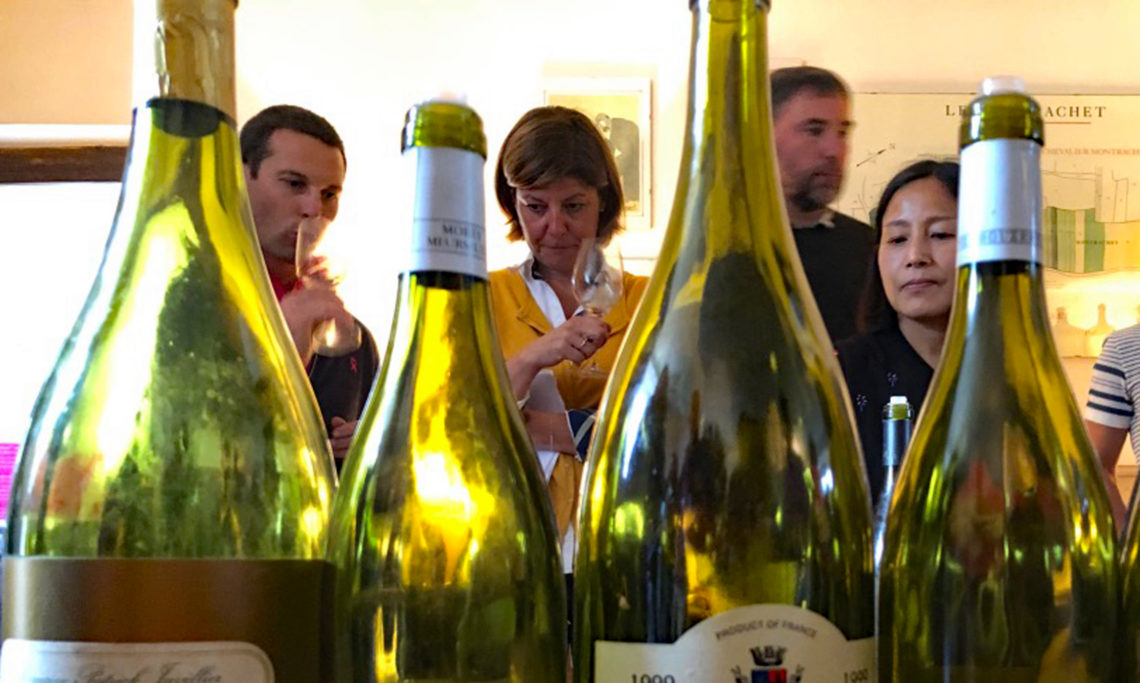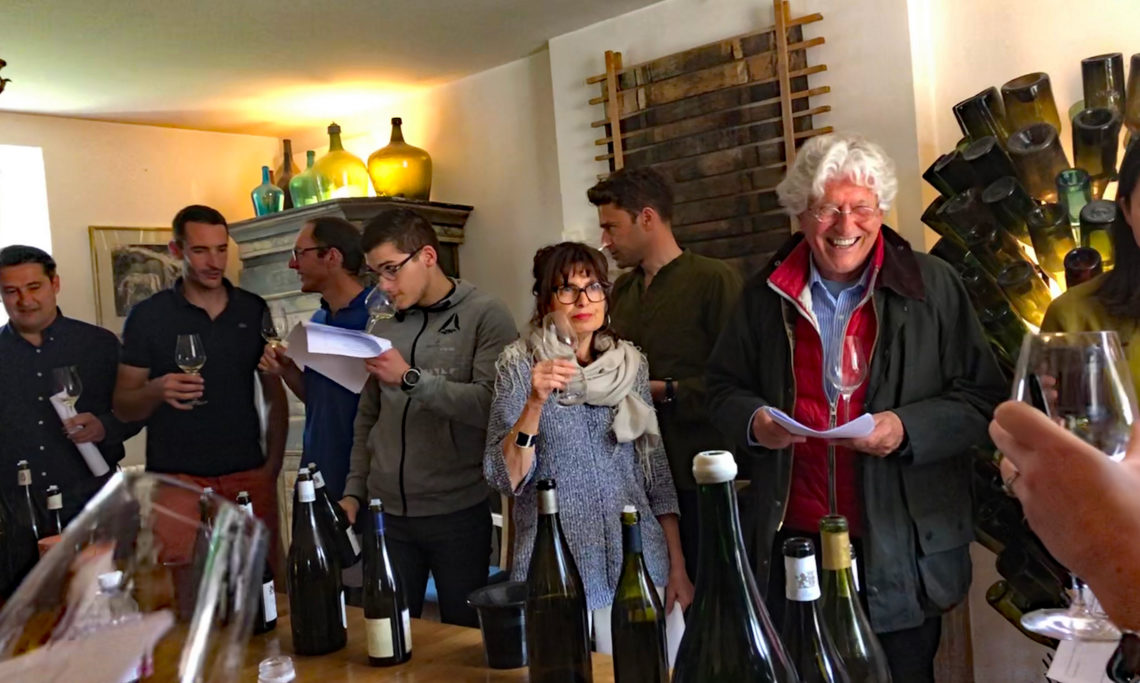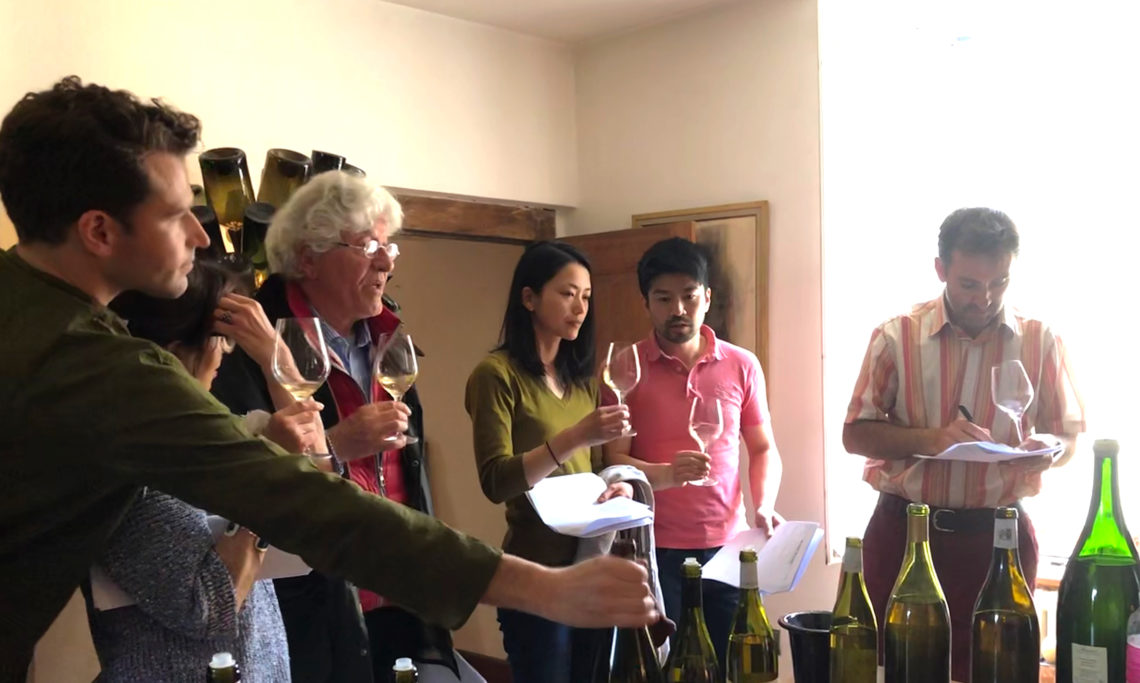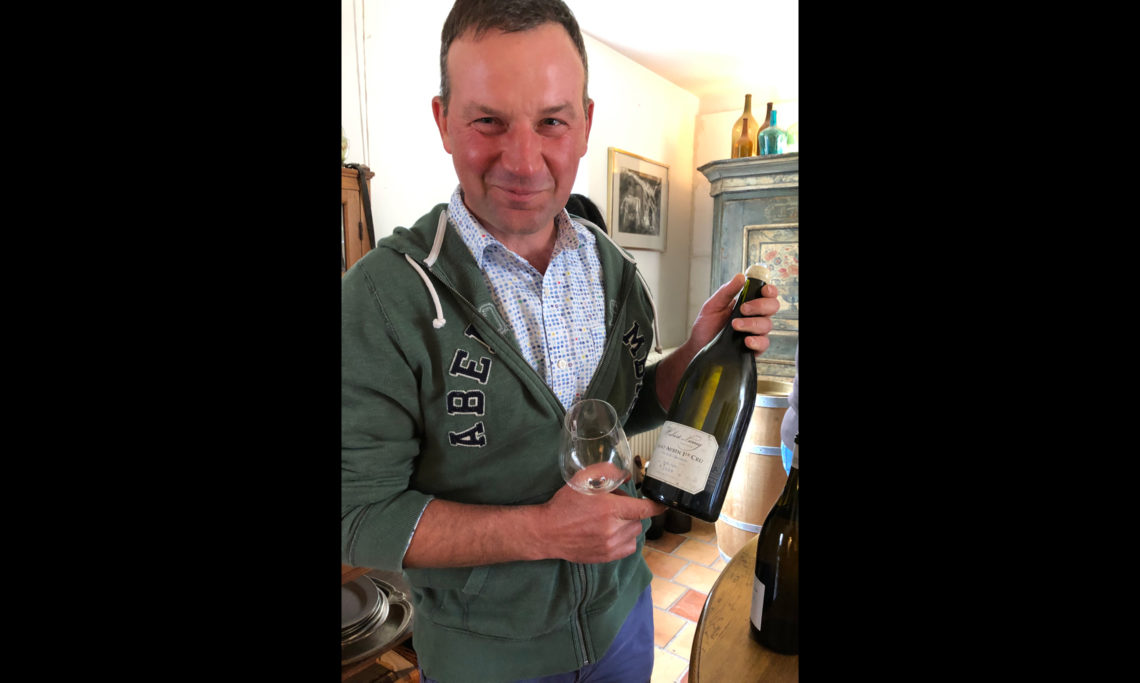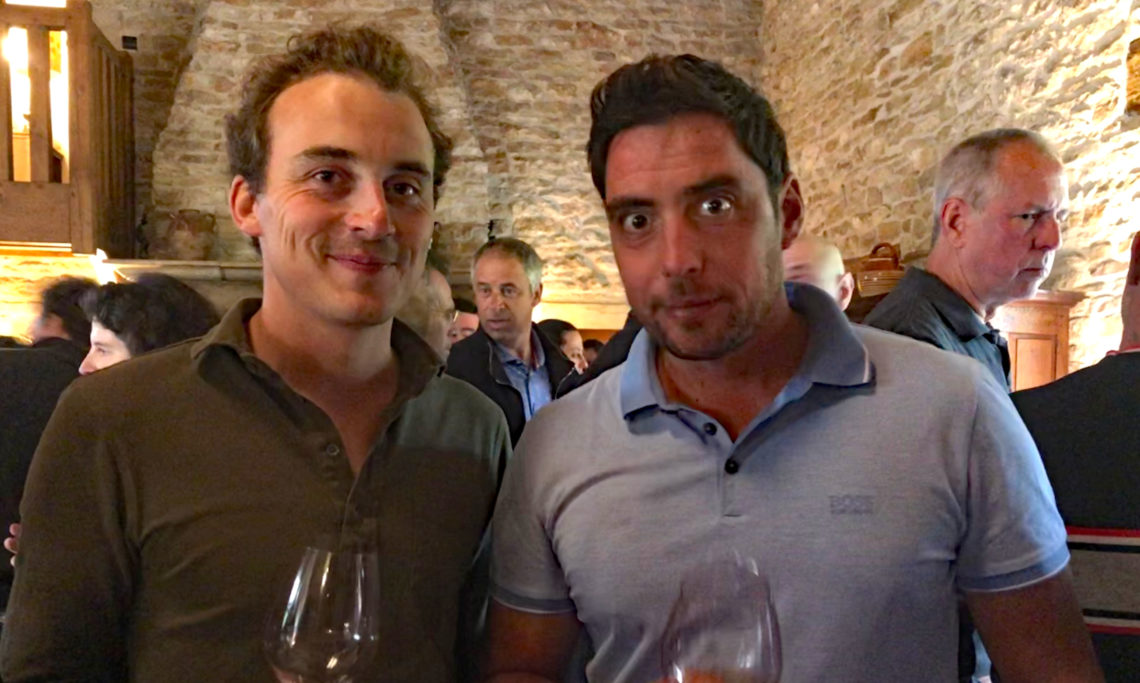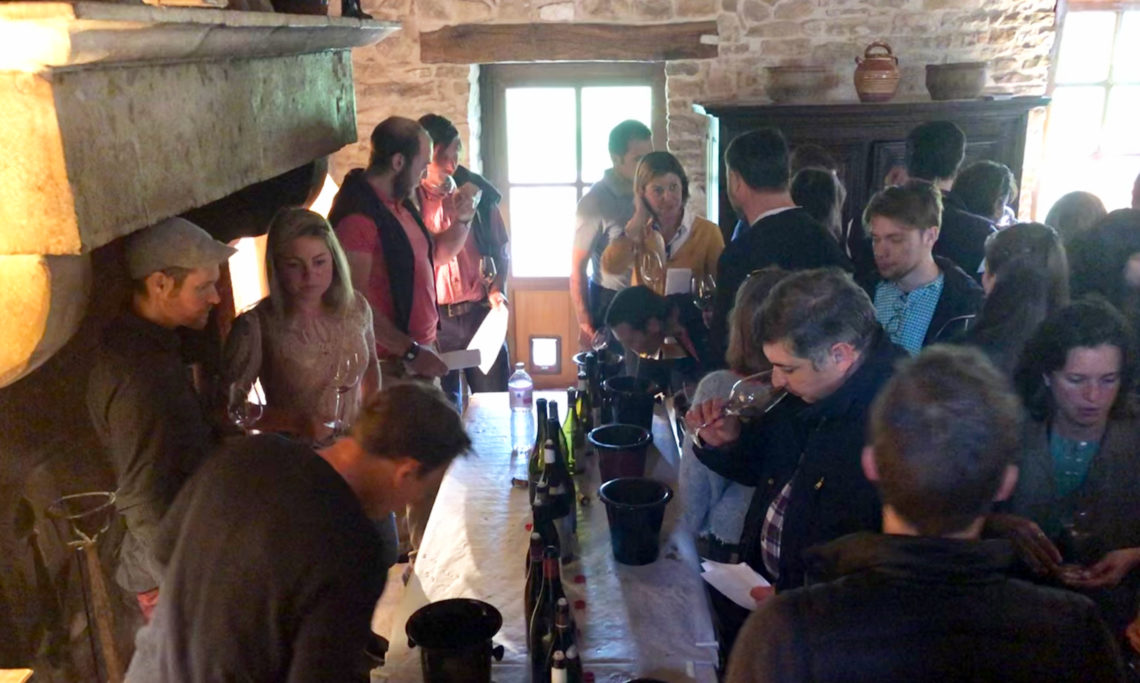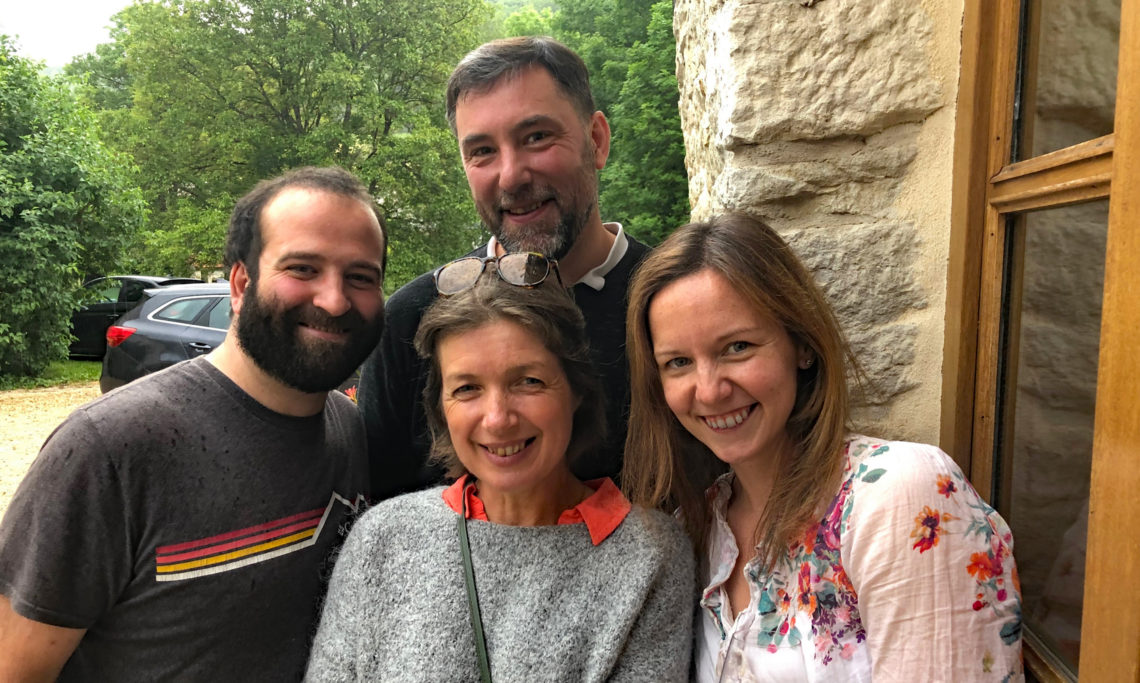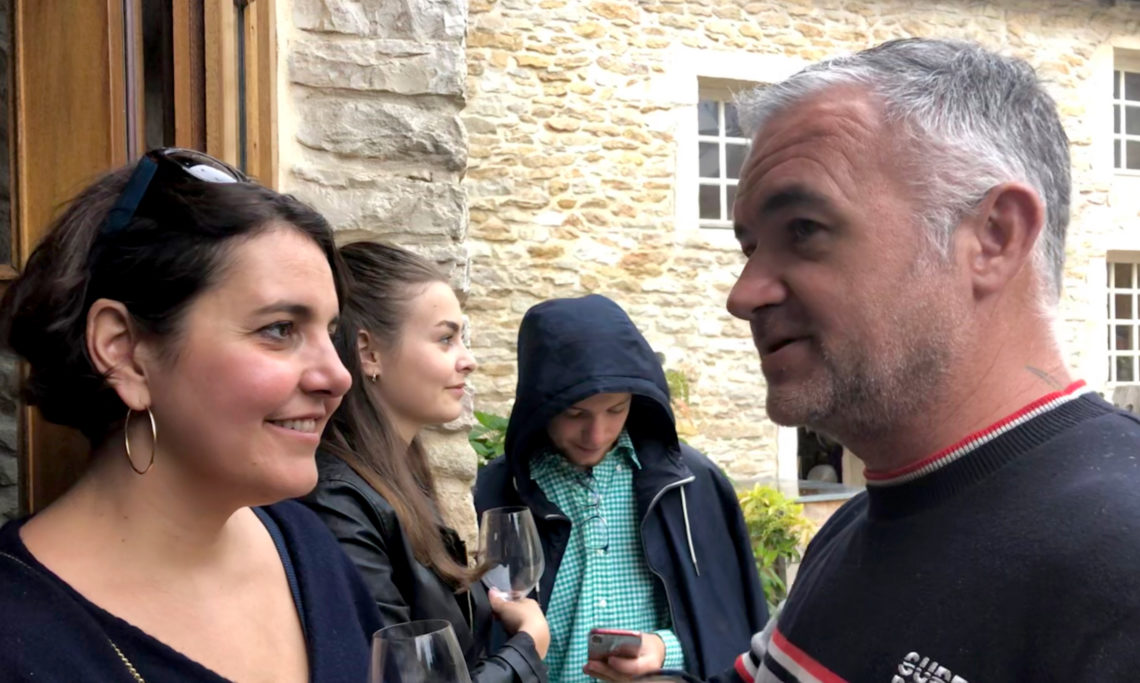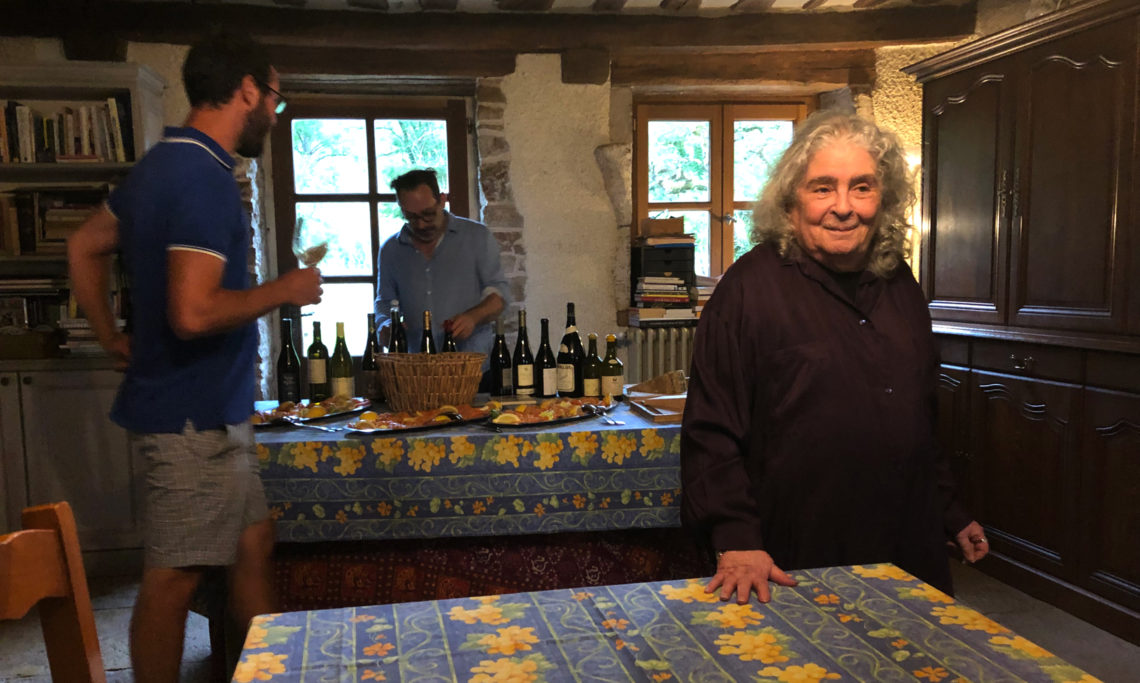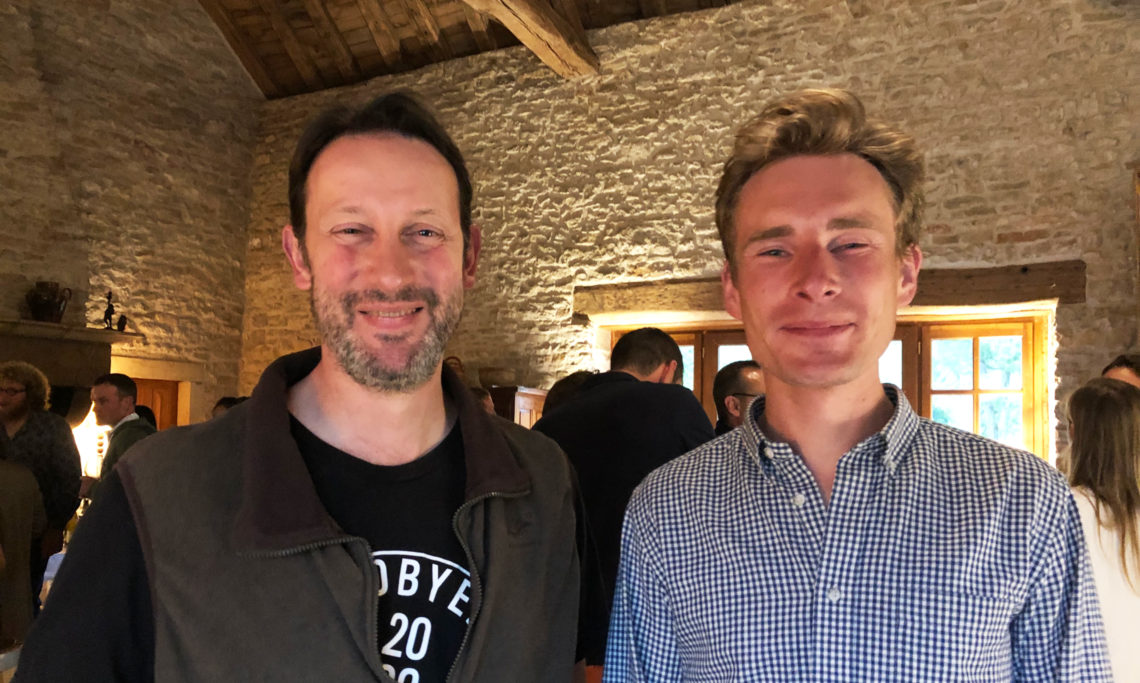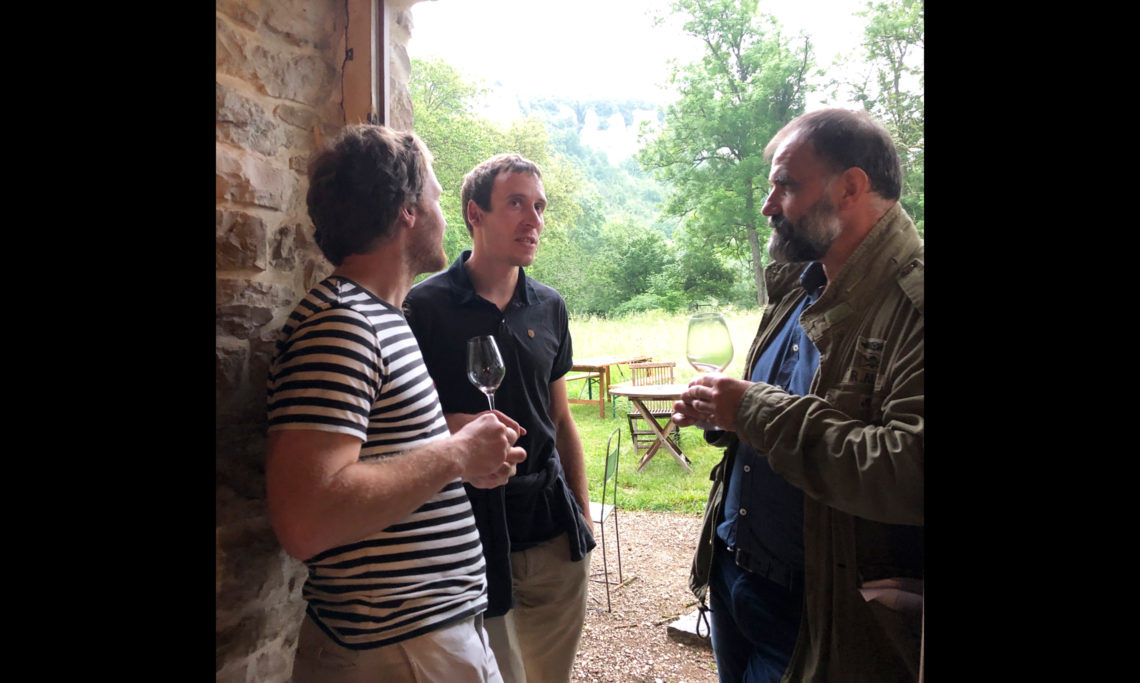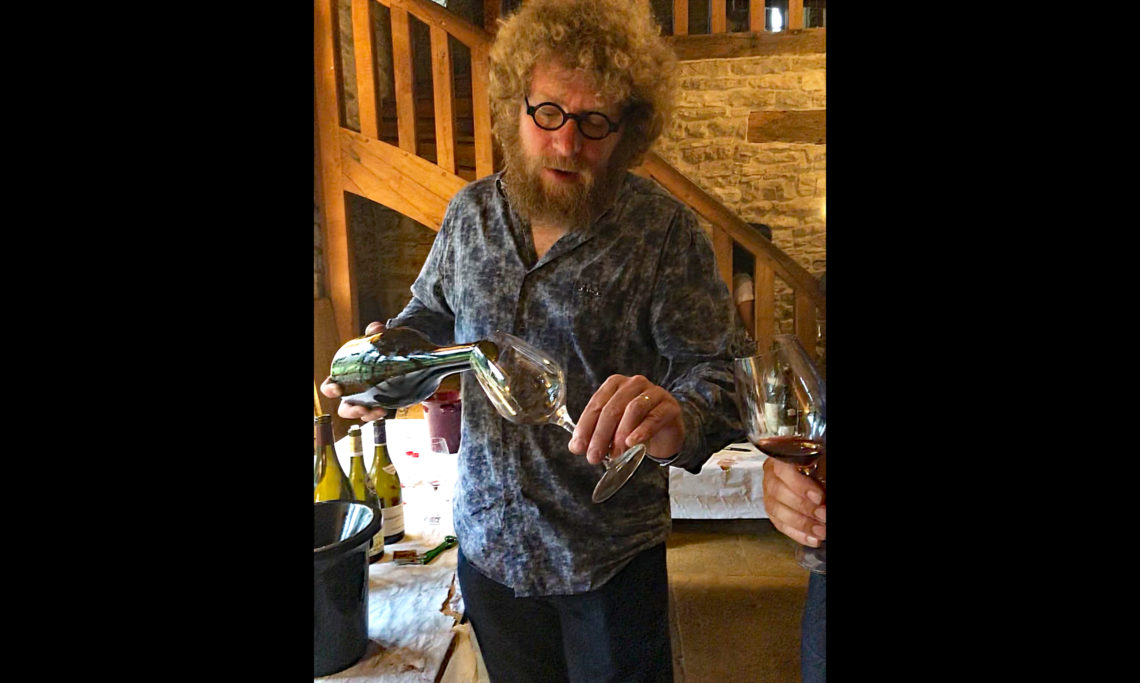By Paul W. —August 2019
Since 1988, we have been hosting a ten-years-on tasting at Becky’s home. With a range of 100 to 150 wines, this is a great way to grab a snapshot of a vintage ten years after it was harvested. It is a very fun afternoon that has become a bit of an institution for the vignerons, who make up almost the entire guest list.
Russell prepares food for those who stay on into the evening. The menu has not changed since the tasting’s inception and the growers who have been attending for years (some since 1988) would not have it any other way. The menu is simple: smoked salmon, huge pots of lentils and sausages, and massive chunks of cheese.
For the longest time, the cheese was Stilton. It was provided by Clive Coates because he was the tasting’s original co-host and he would bring the cheese over from England. Since Clive’s semi-retirement, the co-host has been Jasper Morris. Jasper is our neighbor and cannot bring cheese from England. So, this year, we had Comté that was provided by Guillaume Overnoy (Pierre’s great-nephew) with whom we have just begun working.
Clive would also choose a Champagne to serve as an aperitif; he was quite distraught when we started to include low dosage champagnes in the mix. Russell still serves old port with the cheese. And for a few years now, we have popped a lot of bottles after the tasting —new discoveries, Barolos because we have enjoyed a long friendship with growers there, German wines because Russell keeps a sizeable stash, etc.
There have always been stragglers at the tasting, people who just will not leave. They used to be Alain Burguet, Philippe Engel, and Pascal Marchand. Philippe was a huge personality, one of the most generous and sweetest people we knew, and an incorrigible bon vivant. His wines were always among the top wines at the tasting. This was long before they got the reverence they deserved —sadly, this happened posthumously. The stragglers are now young vignerons. We invite quite a few who have just begun their careers and cannot provide bottles for the tasting. They are the most moved by the event.
This year, for the first time, we scandalously ran out of food. Was it because it rained and people congregated inside? Was it because the tasting has become even more popular? Was it because of all the young —and voracious— vignerons? Either way, Russell promised to make more lentils next year, and Guillaume promised to bring an entire wheel of Comté, as long as we provide the knife to cut it. (Exciting note to self: buy a professional cheese knife with a 55 cm blade.)
The tasting is by no means limited to the Becky Wasserman portfolio. The domaines who very graciously provided 105 wines from the 2009 vintage (76 reds and 29 whites), were:
Stéphane Aladame, Domaine d’Ardhuy, Domaine de l’Arlot, Comte Armand, Arnoux-Lachaux, Ghislaine Barthot, Berthaut-Gerbet, Simon Bize, Jean-Marc Boillot, Louis Boillot, Bouchard Père & Fils, Jean-Marc & Thomas Bouley, Bret Brothers & La Soufrandière, Alain Burguet, Clos de la Chapelle, Robert Chevillon, Pablo & Vincent Chevrot, Bruno Clair, Jean-Jacques Confuron, Domaine des Croix, Jean-Yves Devevey, Digioia-Royer, Domaine Dublère, Domaine Dujac, Philippe Gavignet, Camille Giroud, Henri Gouges, Jean Grivot, Michel Gros, Dominique Gruhier, Lucien Jacob, Louis Jadot, Patrick Javillier, Domaine des Lambrays, Michel Lafarge, Comtes Lafon, Hubert Lamy, Benjamin Leroux, Michel Magnien & Frédéric Magnien, Marchand-Tawse, Domaine Maume, Olivier Merlin, François Mikulski, Bernard Moreau, Pierre Morey & Morey-Blanc, Gérard Mugneret, Mugneret-Gibourg, J-F Mugnier, Sylvain Pataille, Jean-Marc & Hugues Pavelot, Pascal Prunier-Bonheur, Domaine Raveneau, Domaine de la Romanée-Conti, Château des Rontets, Nicolas Rossignol, Rossignol-Trapet, Armand Rousseau, Clos Salomon, Domaine Sérafin, Jean Tardy, A & P De Villaine, Comte Georges de Vogüé.
Some context on the 2009 vintage
In barrel, the 2009 reds were considered by the press to be an excellent, ripe, rich, and delicious vintage. (Reds from both Côtes get 95 points in TWA’s vintage chart.) Allen Meadows noted that due to the ripeness of the vintage, it was not the most terroir transparent, but that it was not as overripe as 2003.
As to the 2009 whites in barrel, Allen was more circumspect: “2009 brings us a group of generally forward and approachable wines but where the underlying character can vary considerably. In fact, so much so that some ‘09s are unduly ripe, fat and heavy, some are no more than agreeable, some are lovely wines that are balanced, pure and reflect their terroirs well and then there are a small number of wines that are simply brilliant.” However, he added that, “with respect to the transparency of the underlying terroir, 2009 is actually better in this regard than many vintages where the wines tend toward very ripe aromas and flavors.”
A year later, when Allen tasted the 2009 reds in bottle, he saw a positive evolution of the wines towards freshness and focus, and extended many of his optimal drinking windows while still noting that 2009 was a mid-term drinking vintage that would arrive at peak maturities between 10 and 15 years of age. As to the whites, he found little to change to his original assessment.
In the market, however, 2008 and 2009 were hinge vintages for Burgundy drinkers. After decades of preferring rich, ripe vintages —just like 2009— and disliking tense and slightly under-ripe vintages —just like 2008— aficionados changed their minds.
2009 is therefore often avoided on wine lists. The whites are especially snubbed. This is unfair. Prompted by tasting several times at the domaine a particularly profound Bonneau du Martray Corton-Charlemagne, a few years ago, we began serving 2009 whites blind to our trade visitors. We would decant them for at least two hours, leaving them in the cold cellar. The decanting would get rid of the baby fat; what was left was a fresh, and profound minerality. Not a single trade visitor guessed the vintage, all of them opting for either a 2008 or 2010 instead. This exercise may not be a referendum for every 2009 white since we had specific go-to wines: Bonneau du Martray Corton-Charlemagne, Michel Lafarge Beaune 1er Cru Les Aigrots Blanc, and various Hubert Lamys. Still, the vintage can be profound for whites too.
The 2009 vintage now
Out of 25 whites, only 3 were overly evolved. Can we hope that as it happened with the even richer 2003 vintage, 2009 whites will be mostly spared from premox?
Though the whites as a group did not have countless years in front of them, as Jasper puts it, they were “in no imminent danger of falling over.”
The higher end of the hierarchy performed extremely well. And two wines were brilliant on an absolute level, regardless of vintage.
As for the reds, they were still very youthful. In this regard, though 2003 was much richer, we can say that both vintages had hung on to their primary fruit at the 10-year mark. It will still take some time for the 2009s to shed it. A couple wines did show oxidation. However, brettanomyces was found on enough wines to consider it as one of the potential pitfalls of the vintage. This is not to be unexpected with high pH, low acidity, and high sugar. How much of a problem this is depends on your own tolerance for brett, and the great majority of the wines were clean.
All in all, the 2009 reds deliver plenty of lush primary fruit. It will take a few more years to shed the baby fat, at which point we expect them to be very popular. Many are structured, but the tannins, overall, are integrated. They certainly were not tiring to taste. In contrast, the more popular 2008 reds were very tiring to taste last year. We are fans of the cooler style of 2008 and even of its edge. But if drinking one bottle over dinner is a pleasure, with the large group we tasted, the under-ripeness got very old, very quickly.
Five-star wines
As we mentioned, the Ten Year Tasting was originally co-hosted by Clive Coates, who published his tasting notes in his newsletter, The Vine. A few years ago, Clive went into semi-retirement. The co-hosting has been taken over by Jasper Morris, who publishes his notes and thoughts on the tasting on his website: InsideBurgundy.com. (You will need a paid subscription to access the tasting notes but not to read his overall impression.)
The reason we mention this is self-serving. Jasper thought the Becky Wasserman domaines did extremely well, grabbing 9 of his 12 five-star spots.
What is a Jasper Morris 5-star wine?
“An outstanding wine in its category. This accolade will be given very rarely, to less than 10% of wines tasted across the vintage. A generic Bourgogne might deserve this reward if it merits 89 or 90 points whereas a Puligny-Montrachet Les Pucelles would need 96 for the same result.”
Jasper uses two scales to rate wines. The first one is the now classic 100-point numerical scale and requires no explanation. Additionally, Jasper uses a five-star scale to rate wines within their appellation level. This is an excellent solution to the “clumping” problem of the 100-point scale, since, let’s face it, the vast majority of the wines from serious terroirs are at the very least well made —all get a decent numerical score. The unfortunate pitfall of this system is that the best villages are clumped between 90 to 92 points, premiers crus between 91 to 94 points (with the occasional super Premier Cru rising above that mark), and that most regional appellations must necessarily fall under 90 points, a bar beneath which few drinkers who rely on scores for their purchases will limbo. Jasper’s additional star rating does a great job at pointing out the overachievers in each appellation level, and will hopefully draw people’s attention to very deserving wines.
The three five-star 2009s that were not ours were: Domaine Raveneau Chablis Les Clos Grand Cru (from magnum), Domaine Dujac Clos de la Roche Grand Cru, Domaine de la Romanée-Conti Échézeaux Grand Cru.
What is noteworthy, is that none of our five-star wines are Grand Crus. This makes us extremely happy because the chase must be about the most exciting wines regardless of hierarchy.
That Olivier Lamy received the 5-star accolade for his En Remilly is not a surprise. For a number of years now, his wines have systematically been in the very best whites in this tasting —though it should still be noted that this is for his Saint-Aubin 1er Crus, not his Criots-Bâtard-Montrachet or even for his Haute Densité bottlings of the 1ers. If he put those in the tasting, it would be a mic drop. Olivier, quite simply, is at the pinnacle of Burgundy’s talent. On the same note, it is not a surprise either for Lafarge’s Clos des Chênes to receive the accolade.
But in Jasper’s list there are also unexpected wines such as Comte Armand’s Auxey-Duresses, Sylvain Pataille’s Marsannay Clos du Roy, as well as two Beaune 1er Crus from Domaine des Croix. Finally, there are two wines from Domaine Gérard Mugneret. Many were the vignerons who considered these last two domaines to be best in show.
Jasper tasting notes of our five-star wines:
Domaine Hubert Lamy, 2009, St-Aubin En Remilly 1er Cru, 93 points
“From magnum. A very pale clean clear colour, with immaculate purity on the nose. Actually very backward still. Razor sharp on the palate, lemon tinged, mineral, just adding a touch of flesh afterwards. Today I rate this a small notch ahead of the Chatenière.”
Domaine du Comte Armand, 2009, Auxey-Duresses 1er Cru, 93 points
“From magnum. Vigorous bright fresh fruit. The bouquet is so youthful but really classy, and balanced. In magnum at least the wine is only just starting its journey. There are black cherry notes alongside dark raspberry, some tannins at the finish but the fruit wins out. A classical balance overall, still worth keeping.”
Domaine du Comte Armand, 2009, Pommard Clos des Epeneaux 1er Cru, 94 points
“From magnum. The colour is balanced, maybe less intense than their Auxey 1er cru (often the case). The bouquet also shows a balanced restraint but with power waiting in the wings. There is a coolness to this which bodes really well, and tames the voluptuous nature of the 2009 fruit. Tannins are beautifully stylish and the cool mineral finish shows off to great effect.”
Domaine des Croix, 2009, Beaune Pertuisots 1er Cru, Domaine des Croix, 92 points
“Bright youthful red filling the glass. The bouquet has the exuberance wealth of fruit of the vintage plus the cool precision of David Croix’s winemaking. This has a thrilling backbone behind the fruit, and very good length. The oak has been handled well to enhance the whole.”
Domaine des Croix, 2009, Beaune Les Grèves 1er Cru, 93 points
“A rich powerful youthful colour. The noise has an impressive concentration of fruit but is noticeably more backward than the Pertuisots, with a suggestion of a tannic structure to follow. It doesn’t take long for the rich perfumed fruit to swell though. Ultimately there is more weight of fruit here than for David Croix’s Pertuisots and the ripeness is clearly there (some dark fleshy peaches), but held in check.”
Domaine Michel Lafarge, 2009, Volnay Clos des Chênes 1er Cru, 94 points
“A fine youthful vigorous deep red. The bouquet offers a little bit of fruit while retaining so much more for later. Sheer class, perhaps some ripe cherries, but not just one single fruit. This becomes classier and classier with time in the glass, but remains so youthful. Magical interplay between the fine boned tannins and the acidity.”
Domaine Sylvain Pataille, 2009, Marsannay Clos du Roy, 92 points
“From magnum. A brooding deep red to crimson colour, more intense than Longeroies. There is a superb depth of succulent fresh plum fruit on the nose, youthful and very appetising. Beautifully swelling ripe cherry fruit across the palate and a very long fine finish.”
Domaine Gérard Mugneret, 2009, Nuits-St-Georges Les Boudots 1er Cru, 95 points
“From magnum. Clear bright youthful colour, with a really vibrant nose with raspberry threads pushing through the luscious dark cherry notes. This is great wine in a magical place, with a superb suave follow through. Beautifully balanced and with plenty of energy.”
Domaine Gérard Mugneret, 2009, Chambolle-Musigny Les Charmes 1er Cru, 95 points
“Rich bright colour, very youthful. So too is the nose, there is great potential here. Spectacular red fruit on the palate, he has managed to retain a sublime freshness through the palate that gives him the edge.”
The other 2009s from our portfolio that showed superbly on this day were:
- Stéphane Aladame
- Montagny Les Vignes Derrière 1er Cru
- Arnoux-Lachaux
- Latricières-Chambertin Grand Cru
- Jean-Marc Bouley
- Volnay 1er Cru Les Carelles
- Bruno Clair
- Gevrey-Chambertin 1er Cru Les Cazatiers
- Clos Salomon
- Givry 1er Cru Clos Salomon
- Domaine des Croix
- Corton La Vigne au Saint Grand Cru
- Maison Camille Giroud
- Santenay
- Comtes Lafon
- Meursault Les Genevrières 1er Cru
- Hubert Lamy
- St-Aubin Clos de la Chatenière 1er Cru
- Morey-Blanc
- Meursault
- Francois Mikulski
- Meursault Genevrières 1er Cru
- Jacques-Frédéric Mugnier
- Chambolle-Musigny Les Amoureuses 1er Cru
- Sylvain Pataille
- Marsannay Les Longeroies
- Château des Rontets
- Pouilly-Fuissé Les Birbettes
- Nicolas Rossignol
- Volnay Ronceret 1er Cru
- La Soufrandière
- Pouilly-Vinzelles Les Quarts
These 2009s, not from our portfolio, were also superb:
- Domaine de l’Arlot
- Nuits-Saint-Georges Clos des Forêts St Georges 1er Cru
- Jean-Marc Boillot
- Puligny-Montrachet Champ Canet 1er Cru
- Domaine Chevrot
- Maranges Le Croix Moines 1er Cru
- Louis Jadot
- Beaune Clos des Ursules 1er Cru
- Bernard Moreau
- Chassagne-Montrachet la Maltroie 1er Cru
- Bernard Moreau
- Chassagne-Montrachet la Cardeuse 1er Cru (red)
- Henri Gouges
- Nuits-Saint-Georges Les Pruliers 1er Cru
- Domaine des Lambrays
- Clos des Lambrays Grand Cru
- Armand Rousseau
- Chambertin Grand Cru
- Armand Rousseau
- Chambertin Clos de Bèze Grand Cru
For a few years now, some vignerons have provided wines that are two decades old. This year, the 1999 stunners were:
- Simon Bize
- Savigny Aux Guettes 1er Cru from magnum
- Bruno Clair
- Gevrey Chambertin Les Cazetiers 1er Cru
- Bruno Clair
- Gevrey Chambertin Clos Saint-Jacques 1er Cru
- Domaine Dujac
- Clos de la Roche Grand Cru
- Mugneret-Gibourg
- Echezeaux

